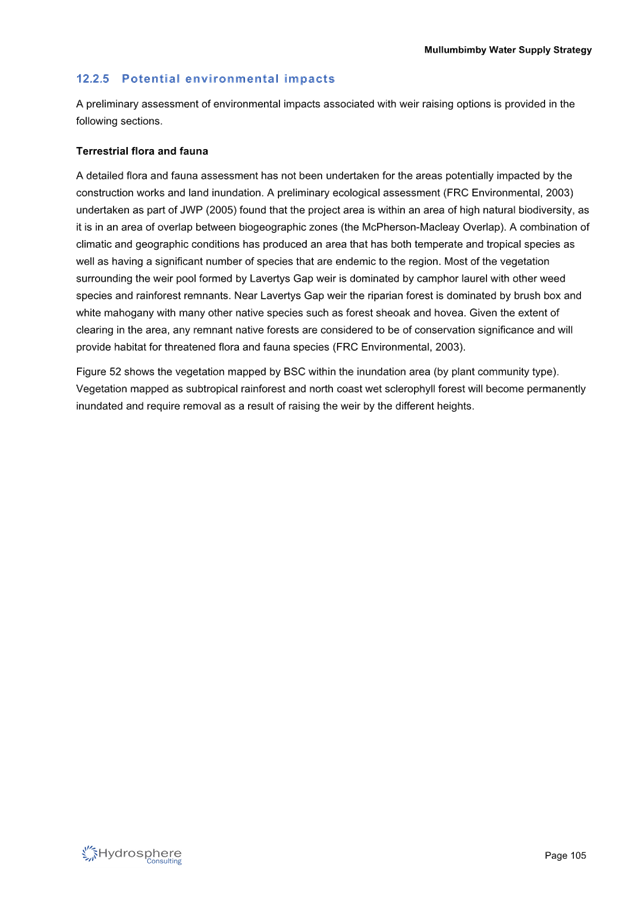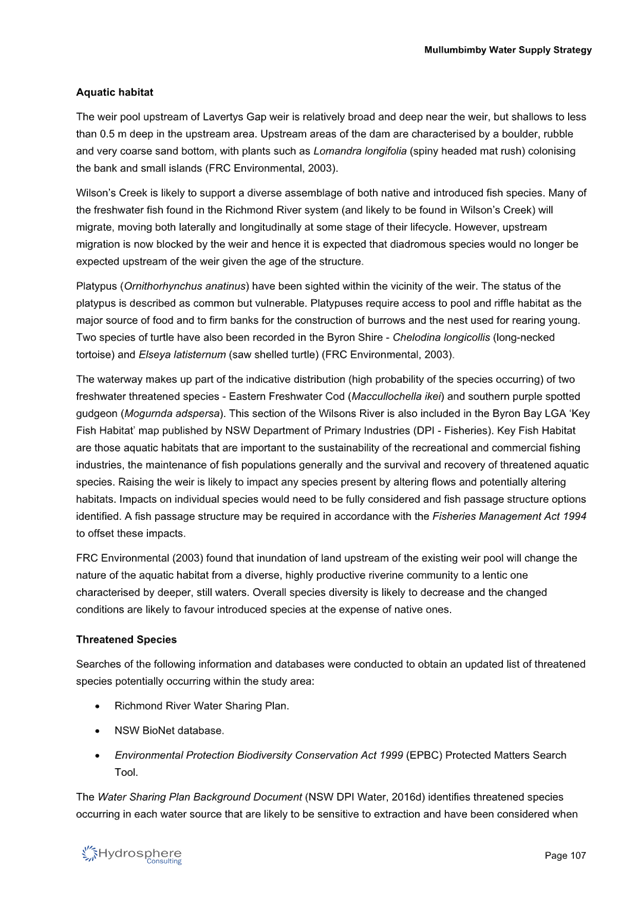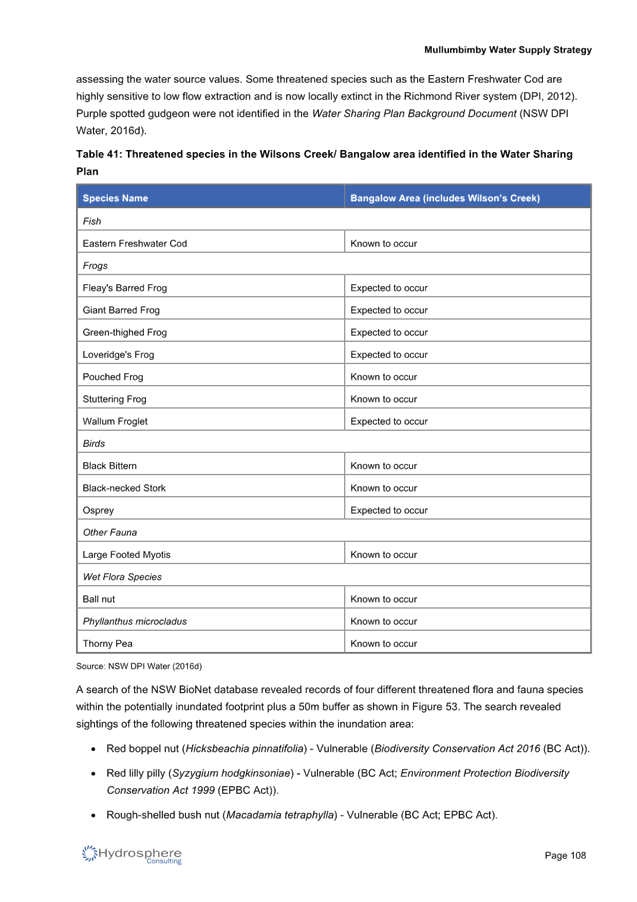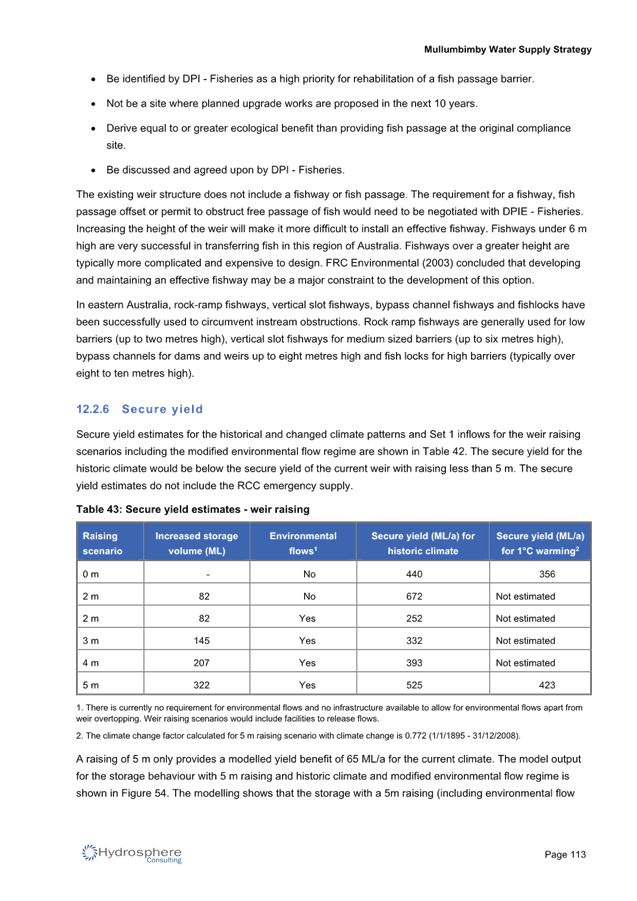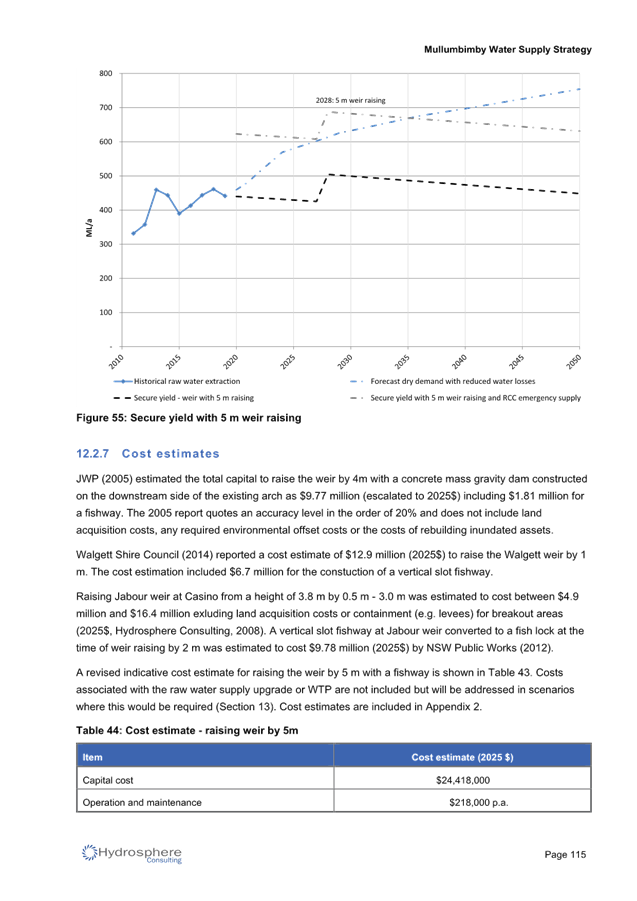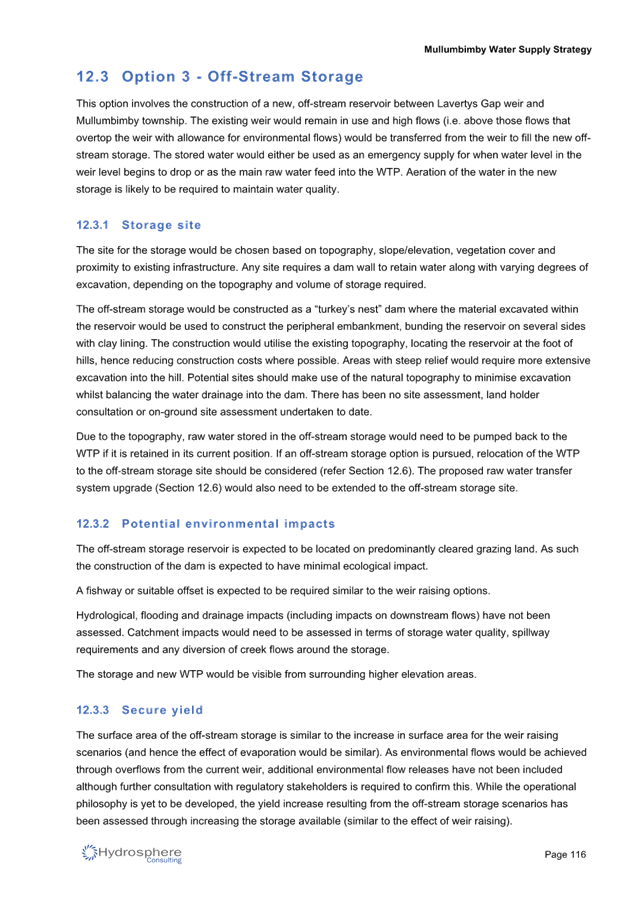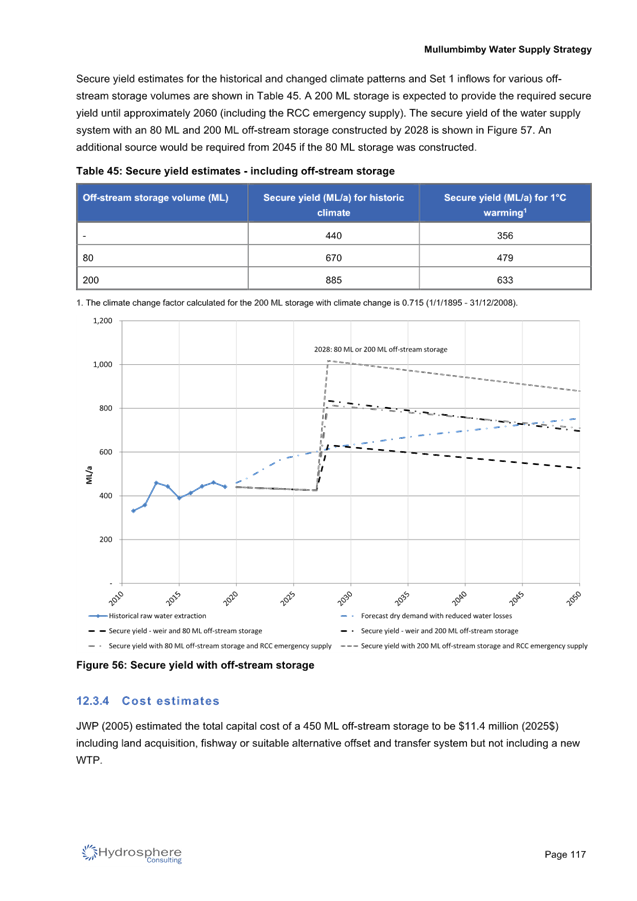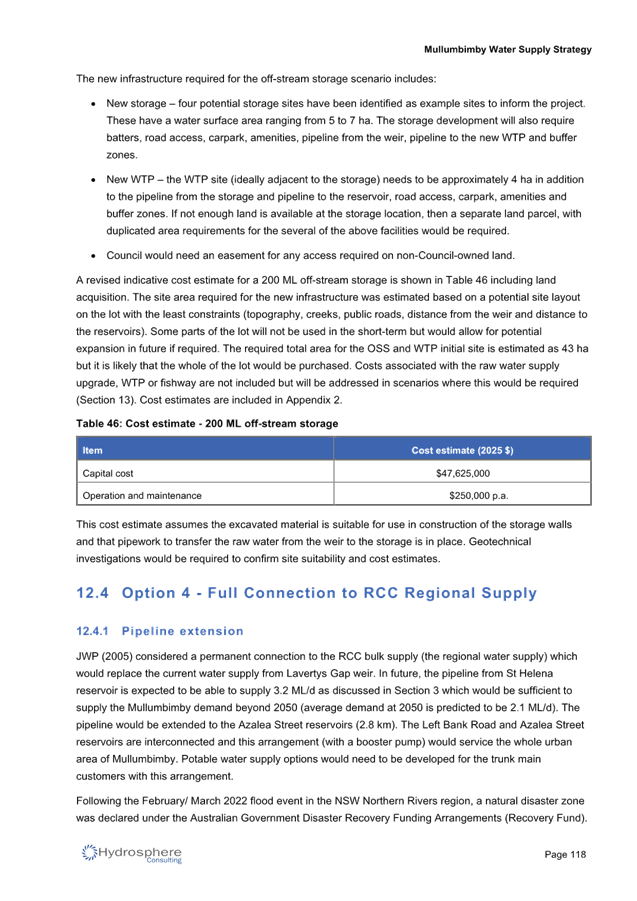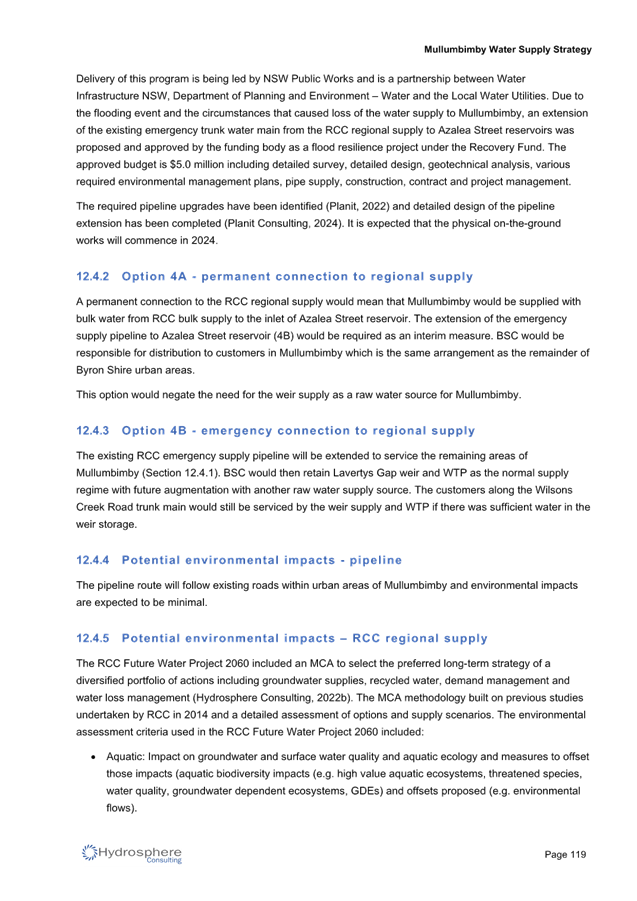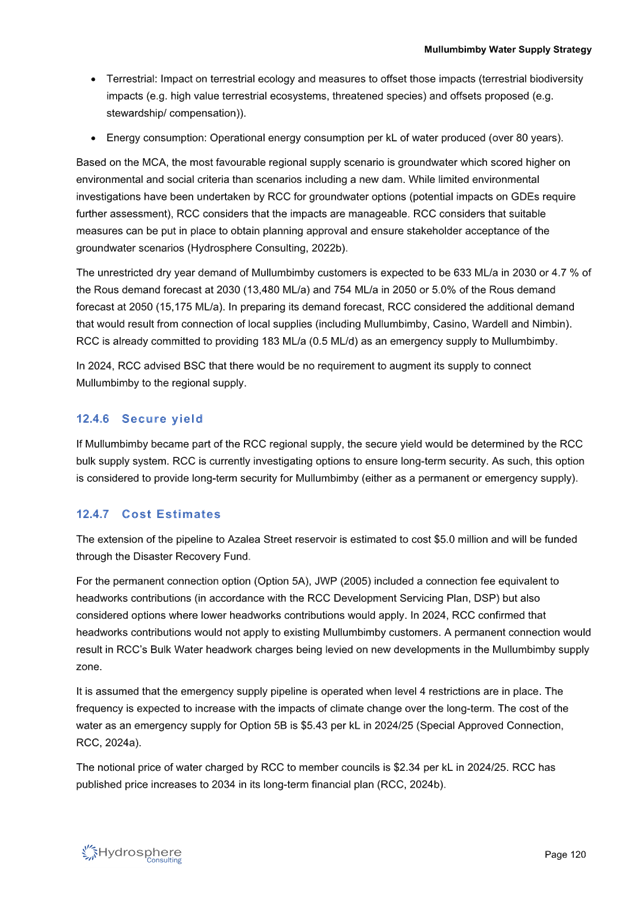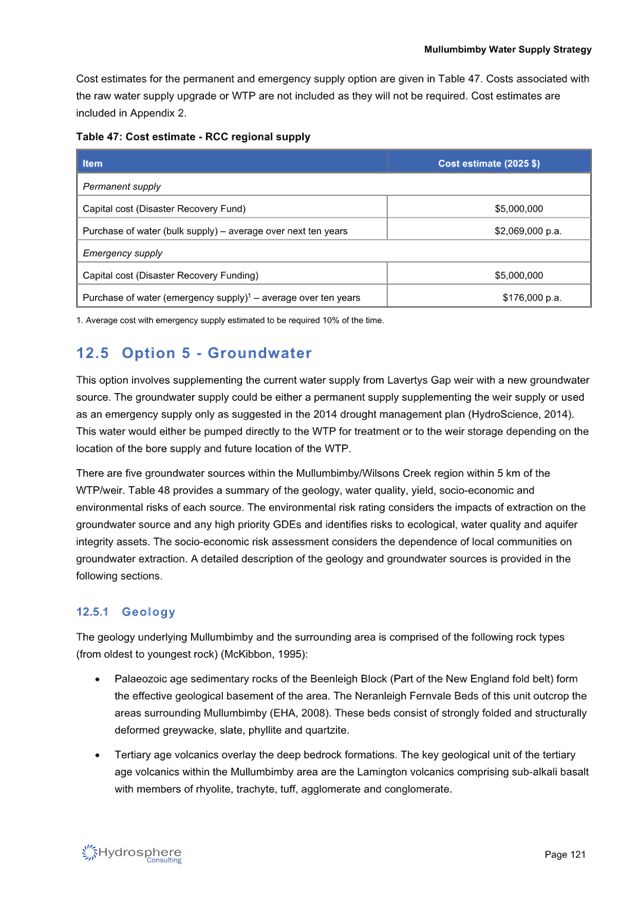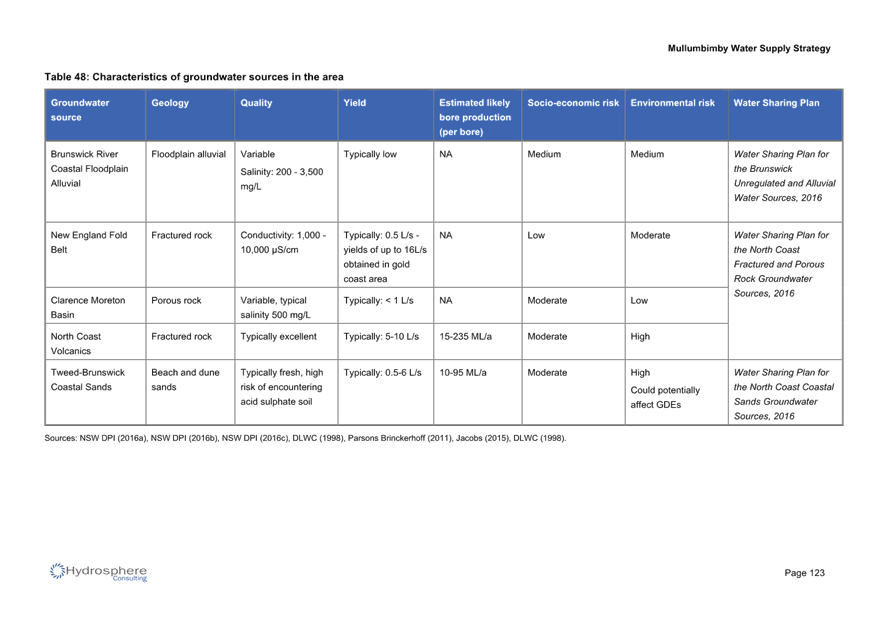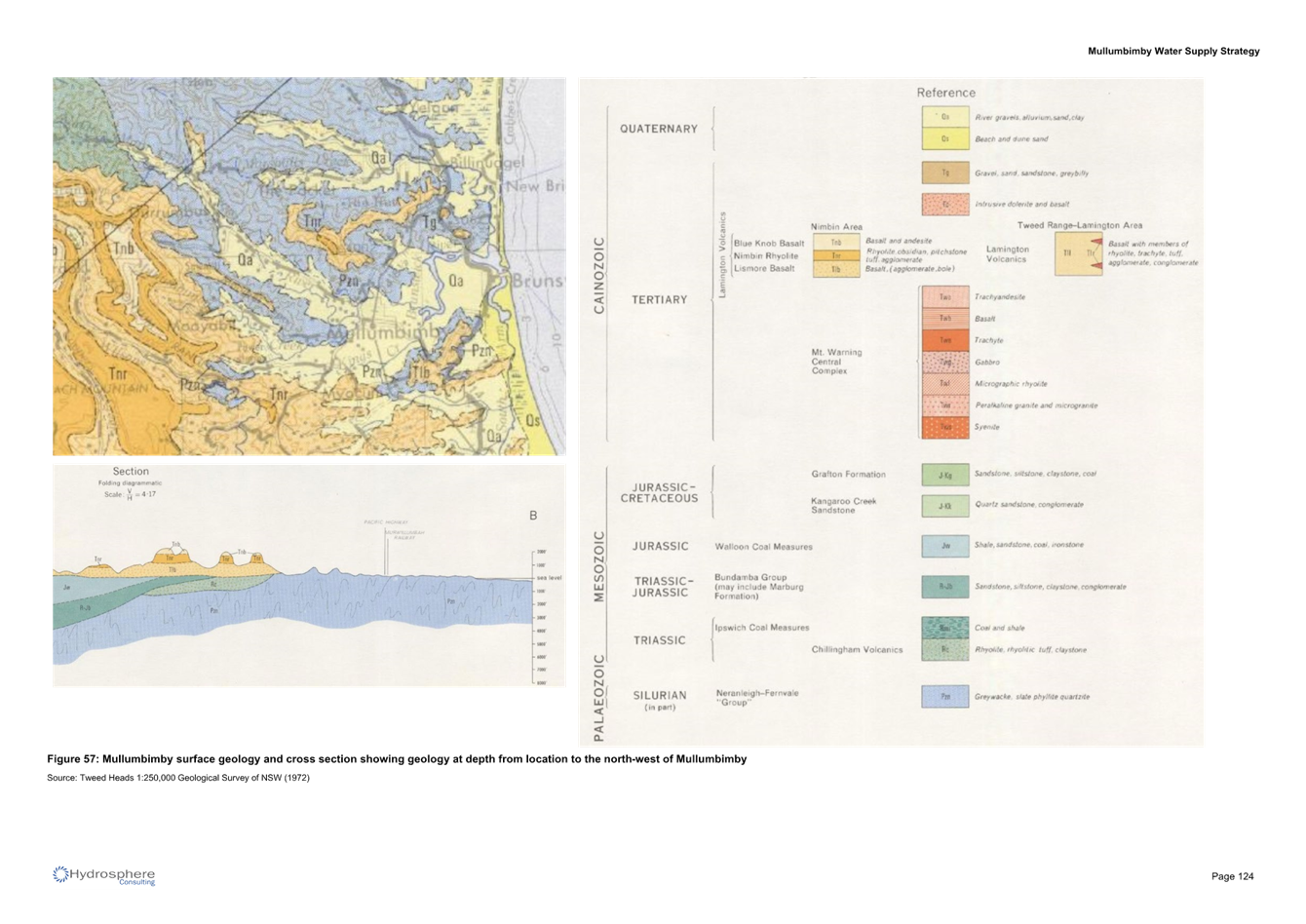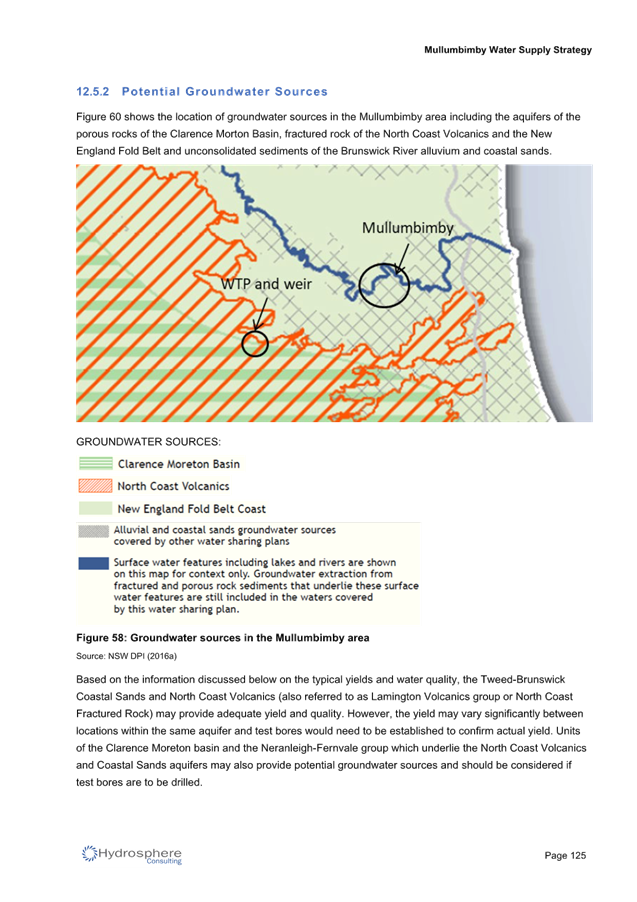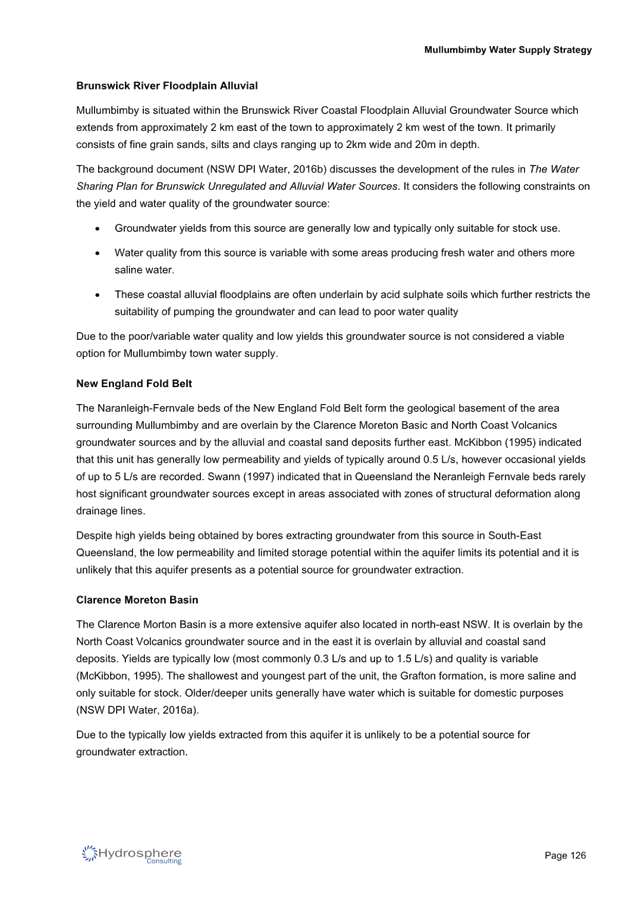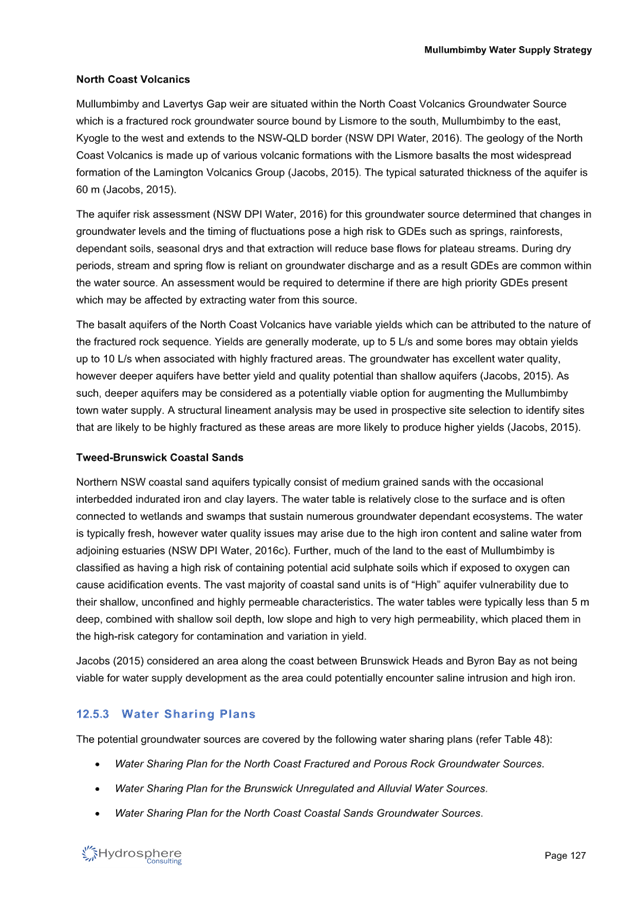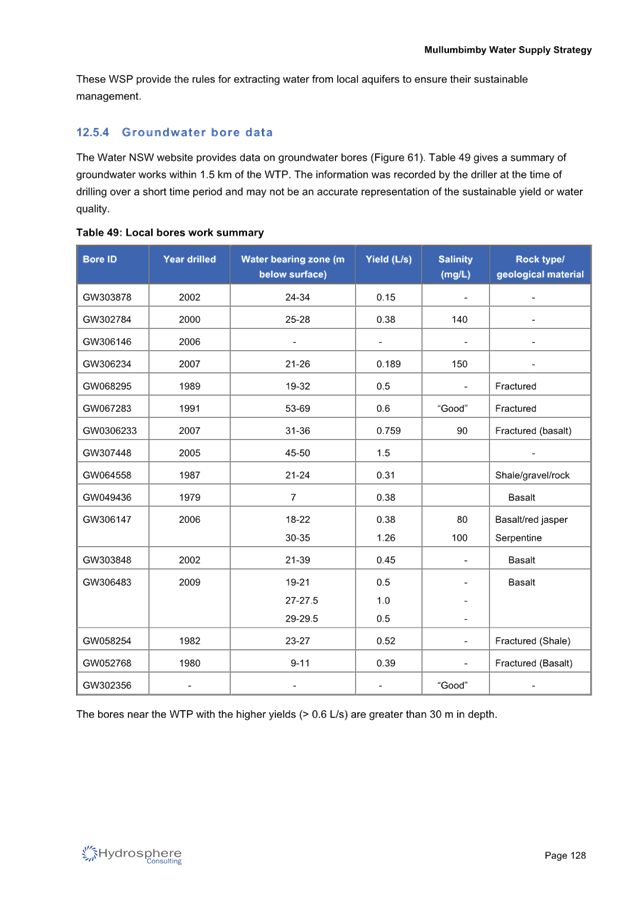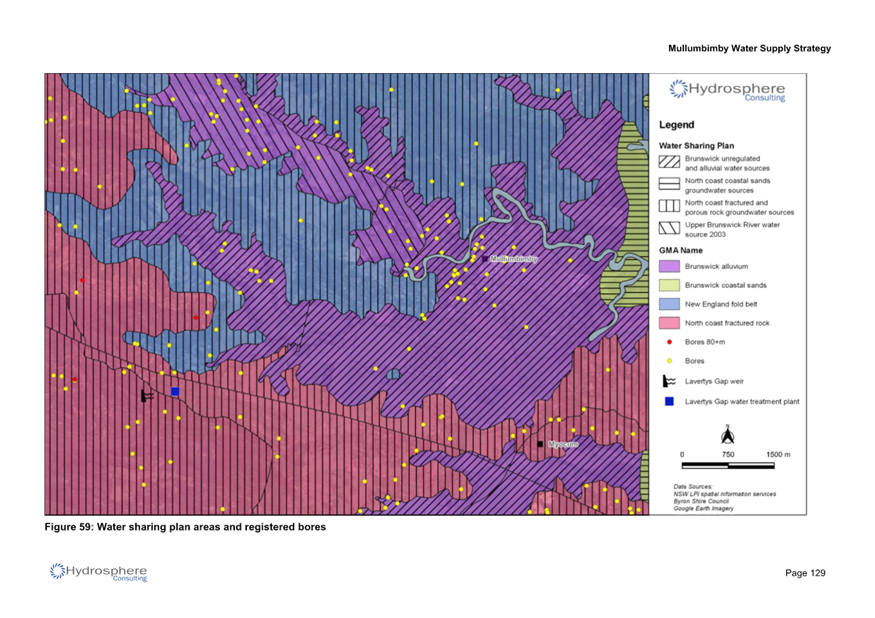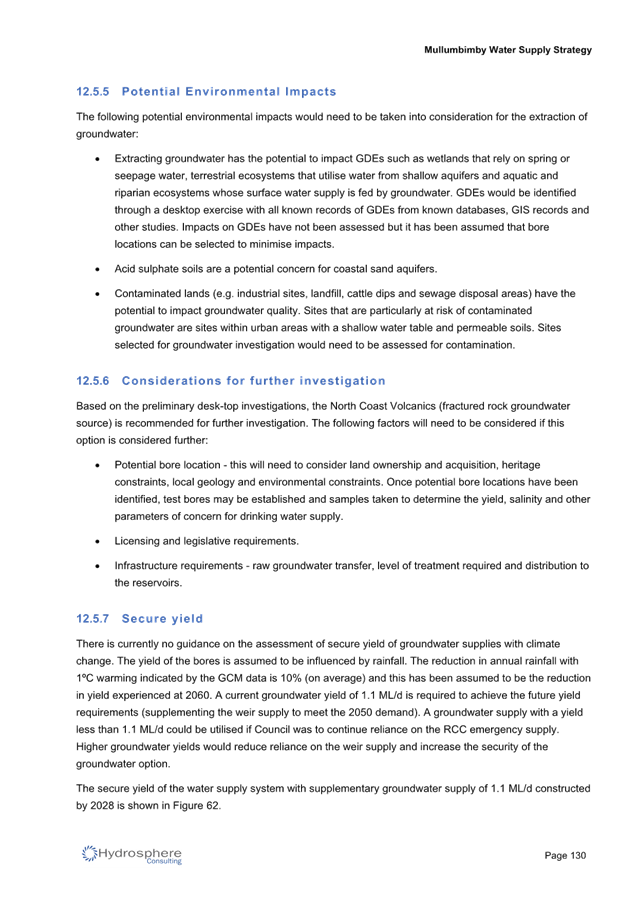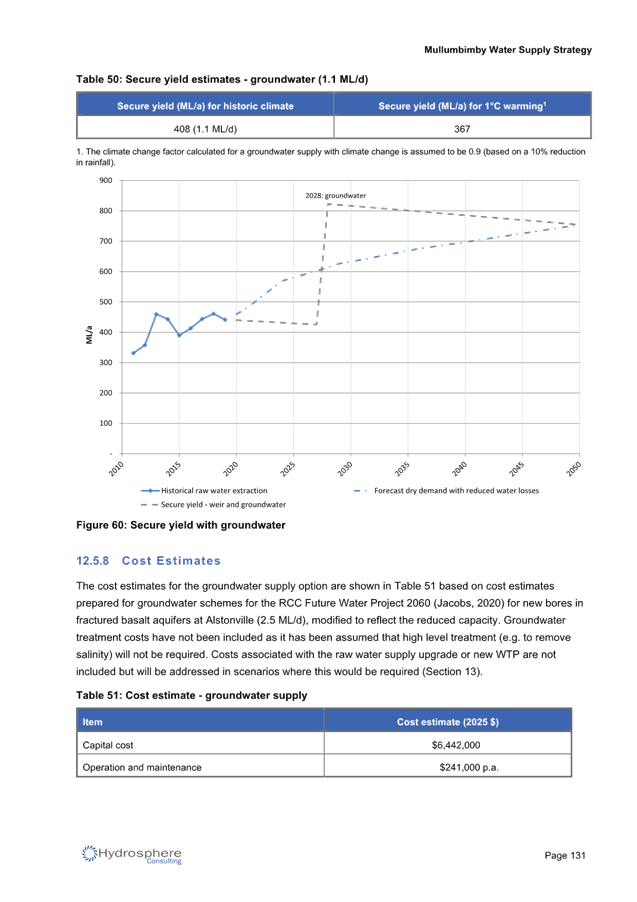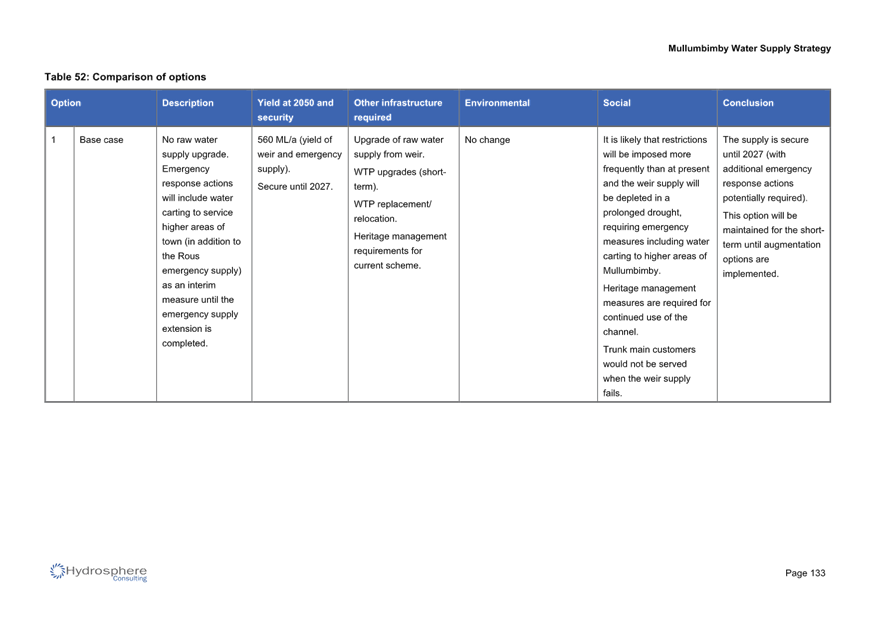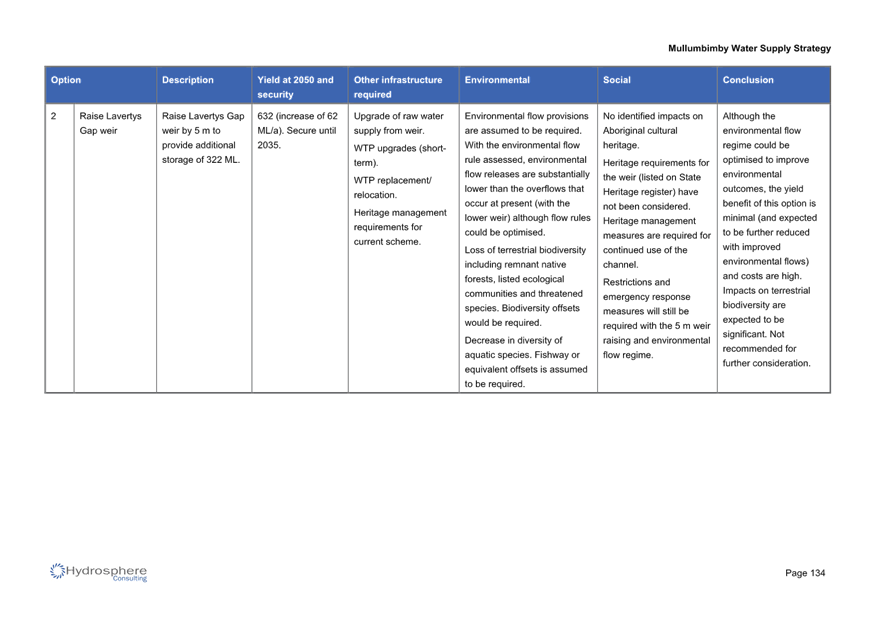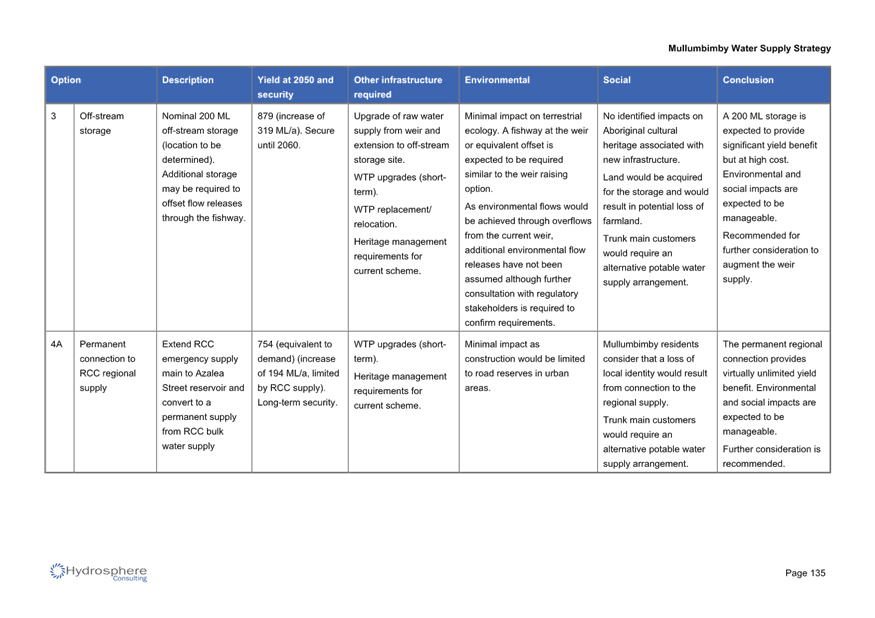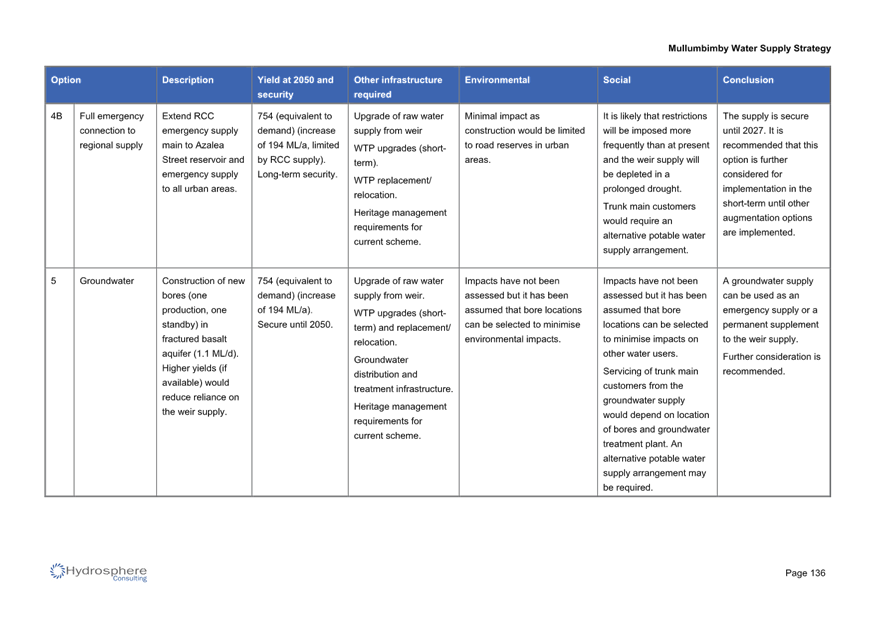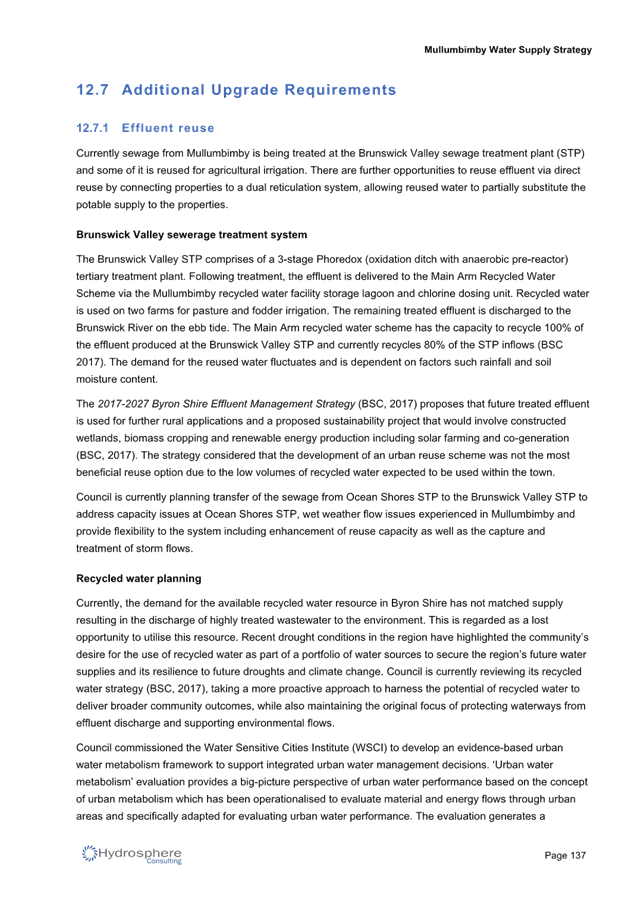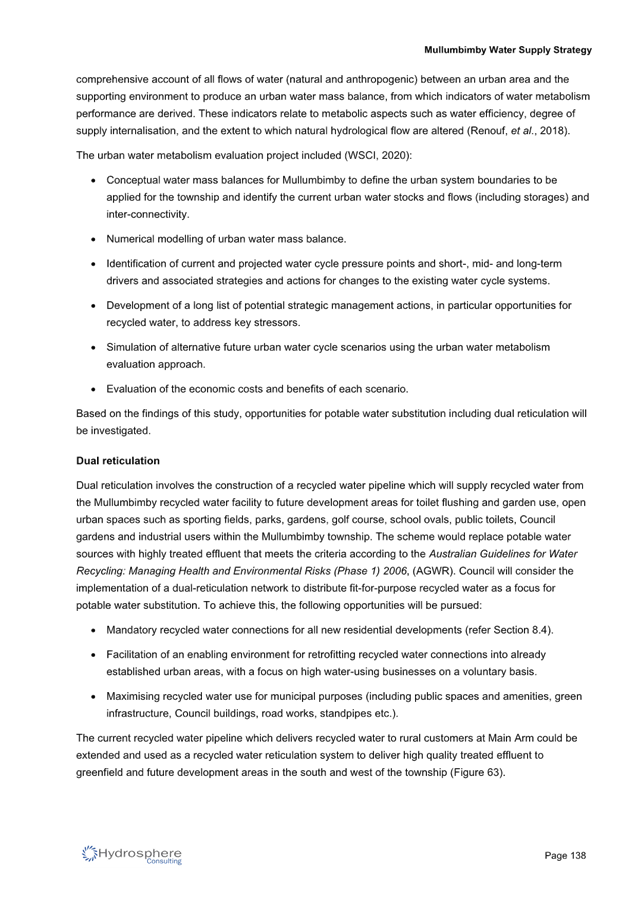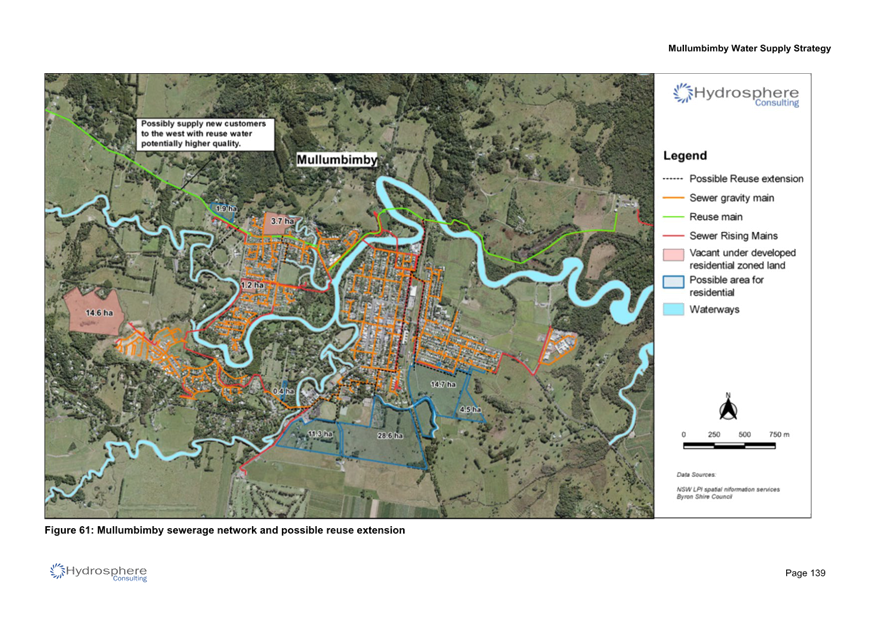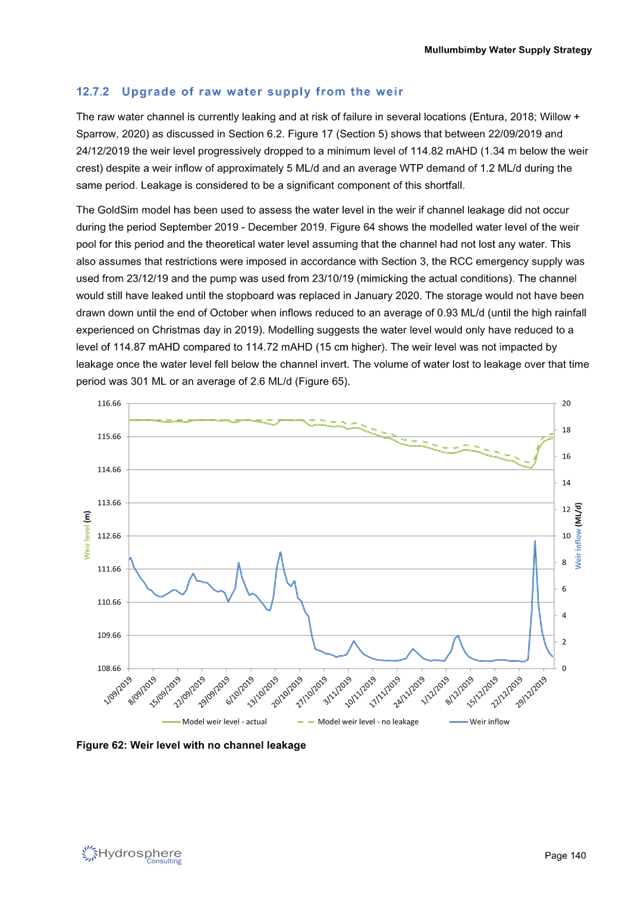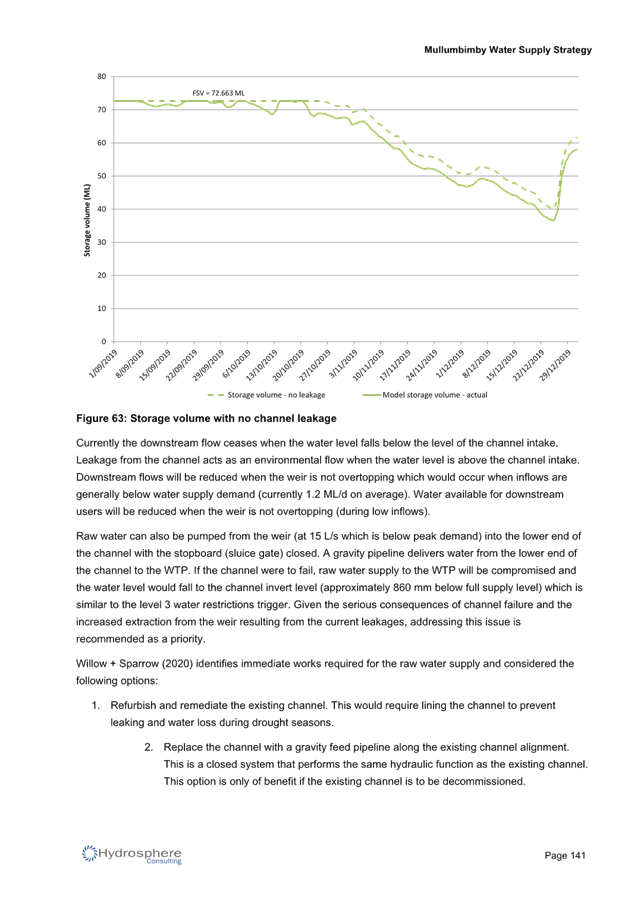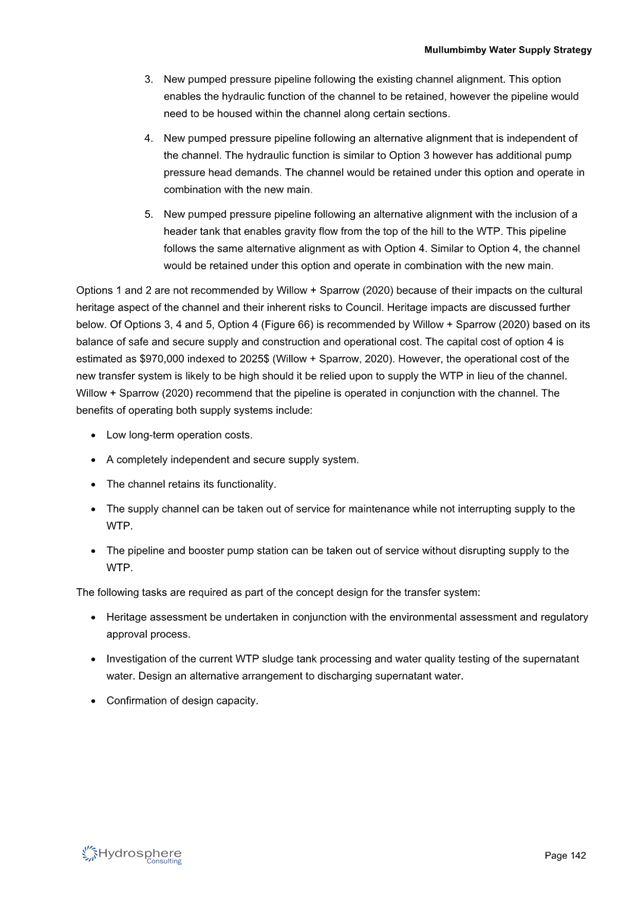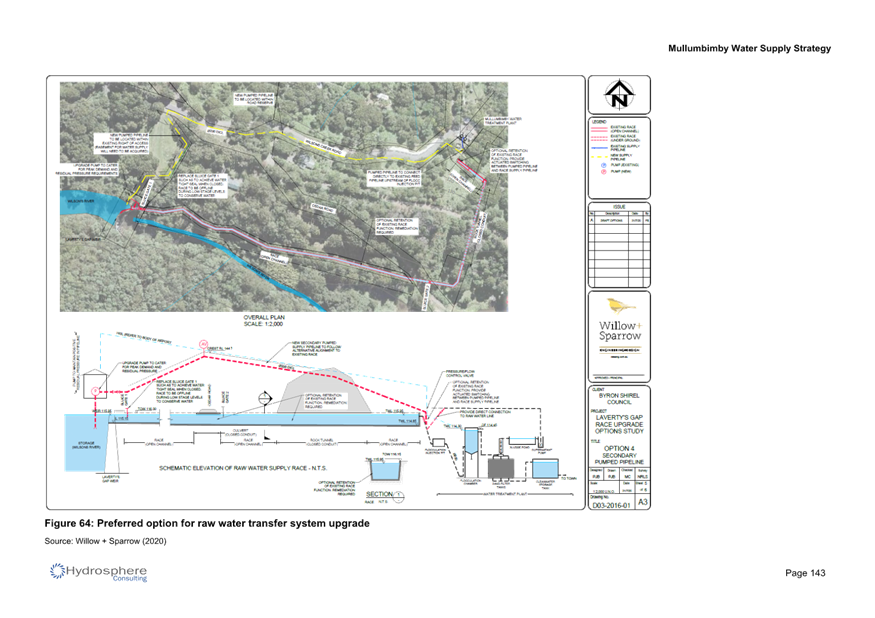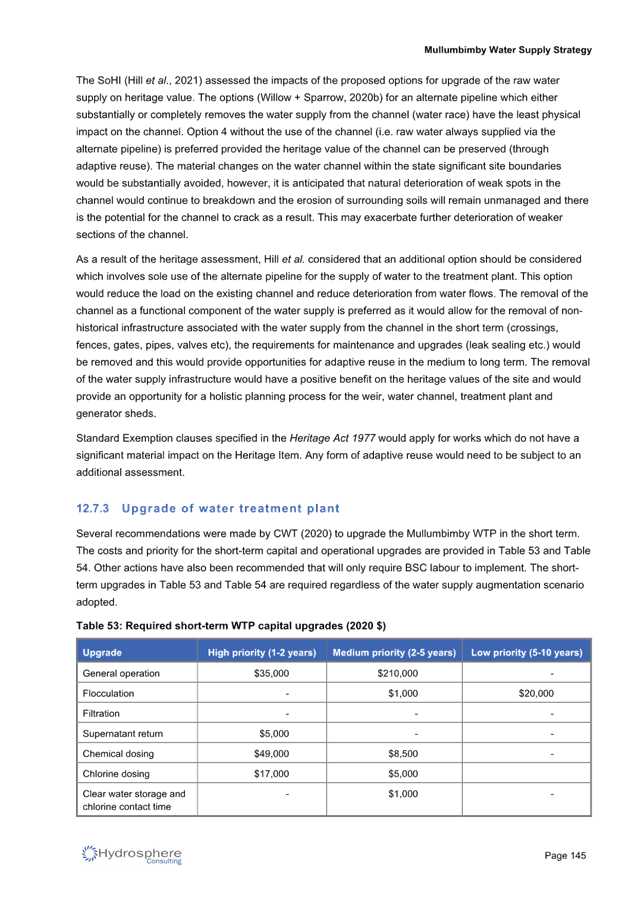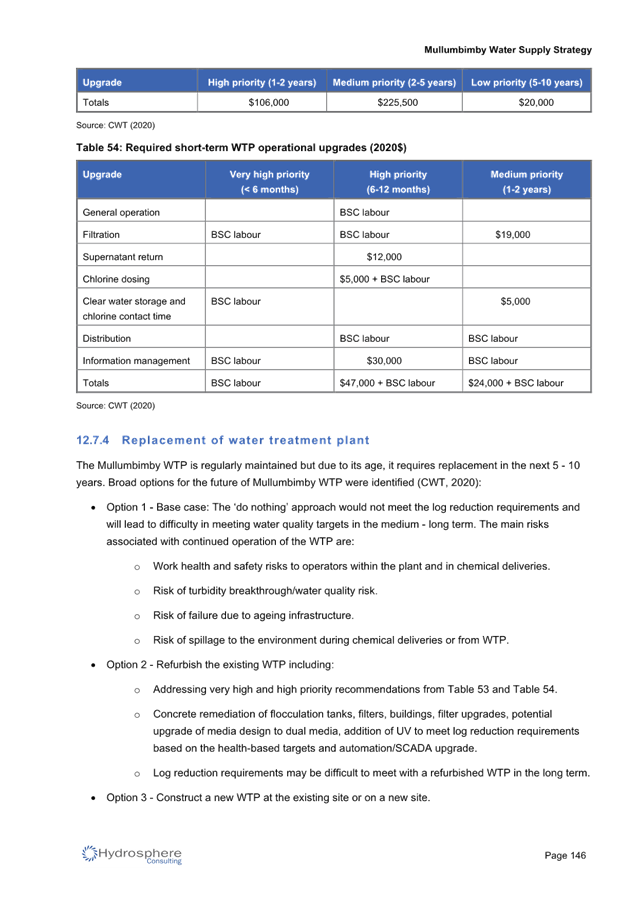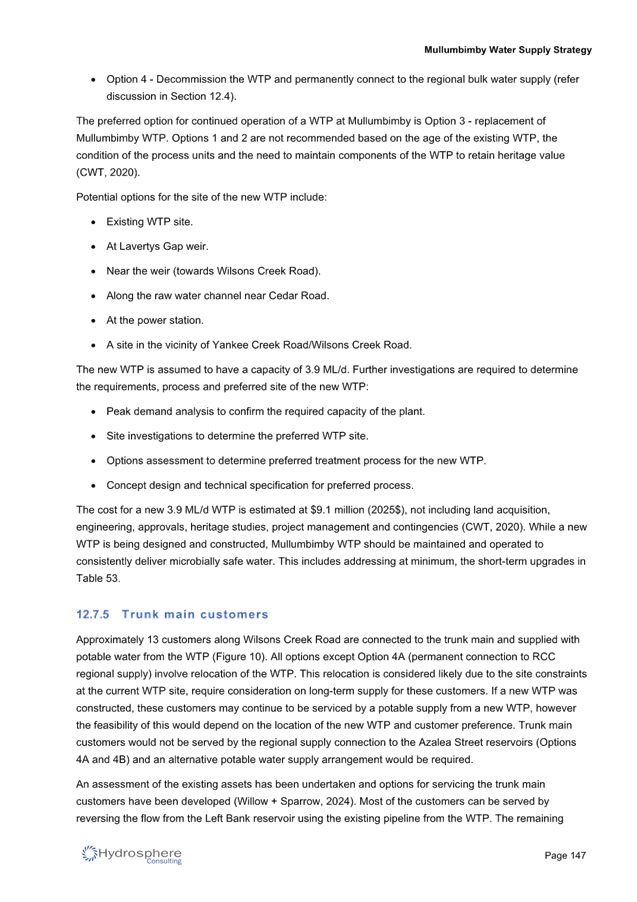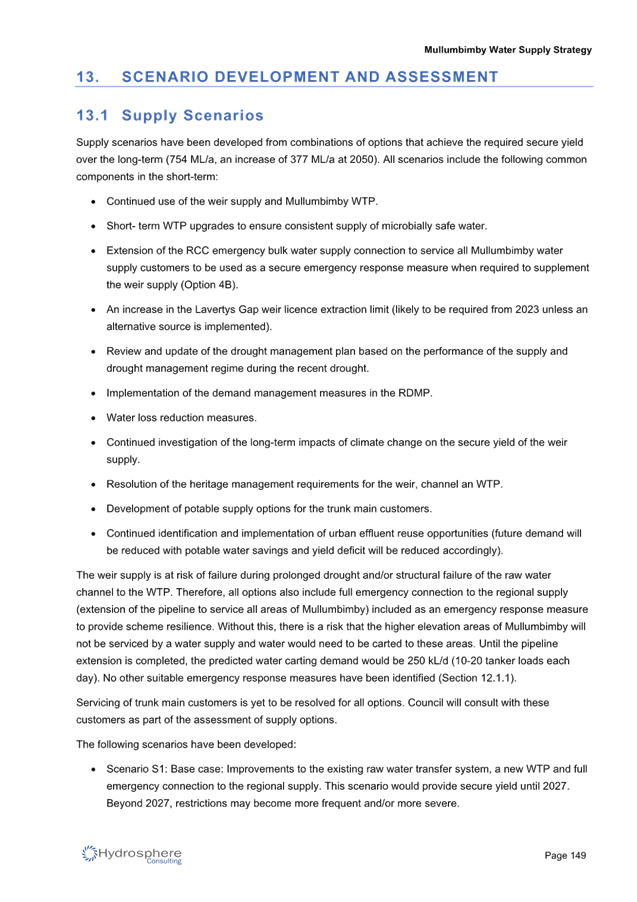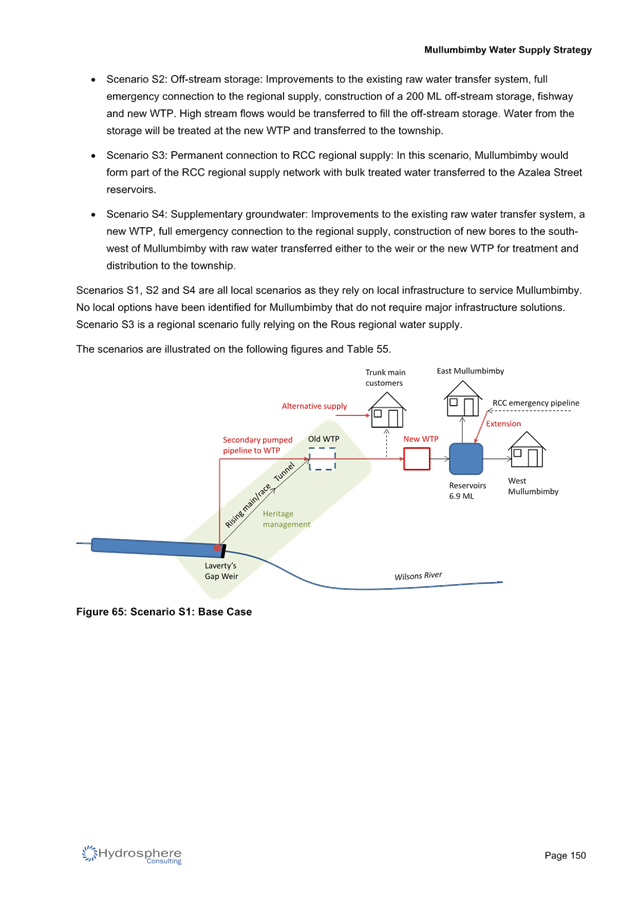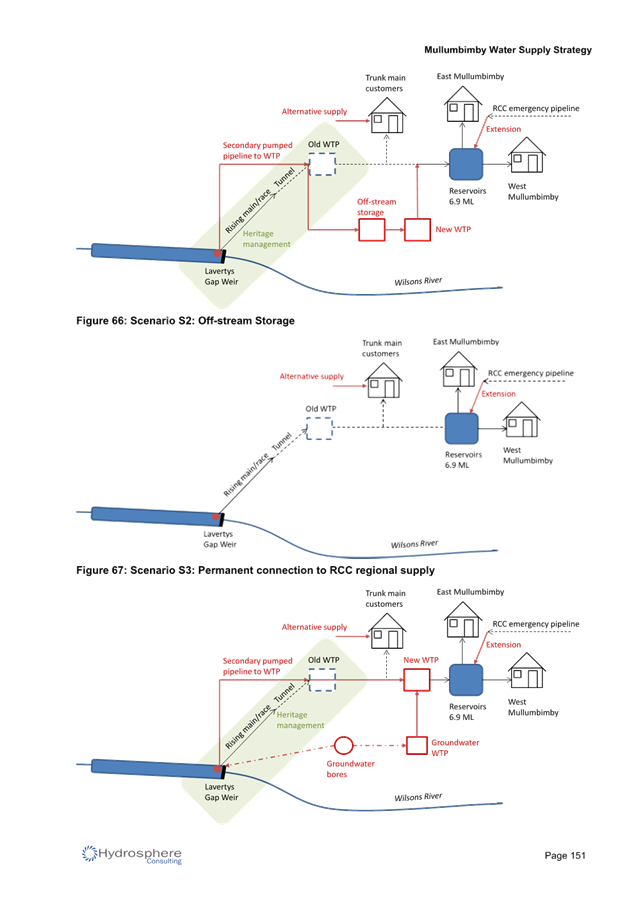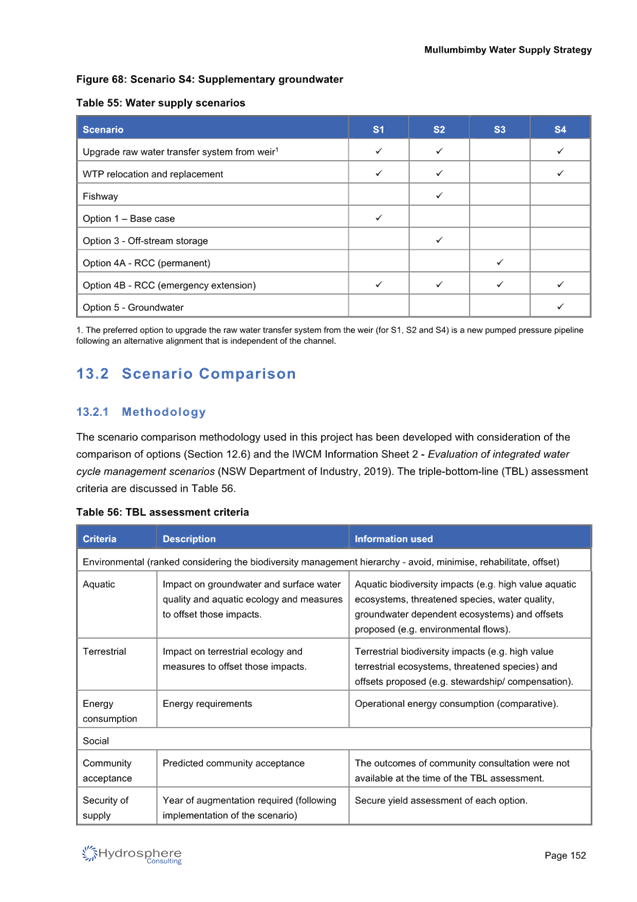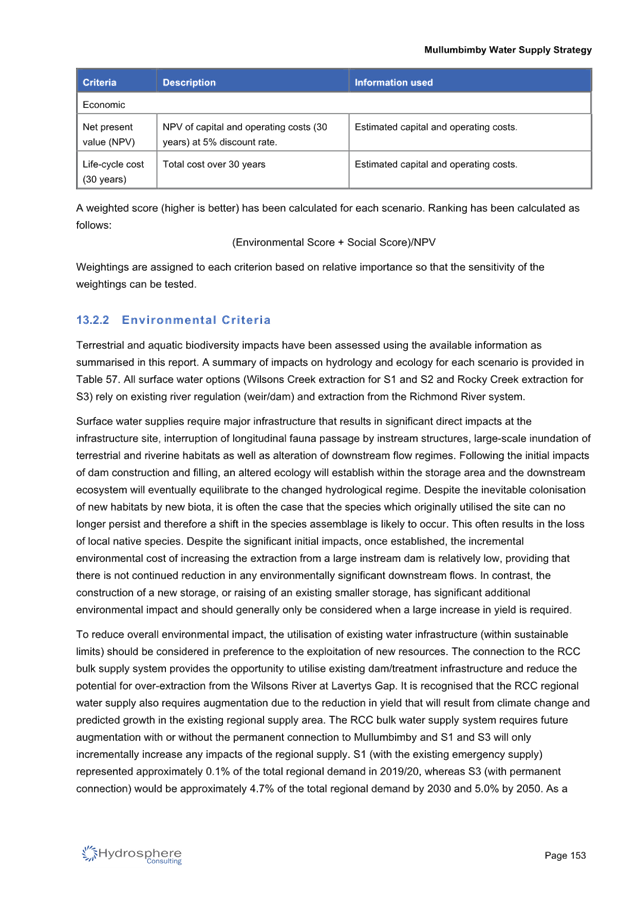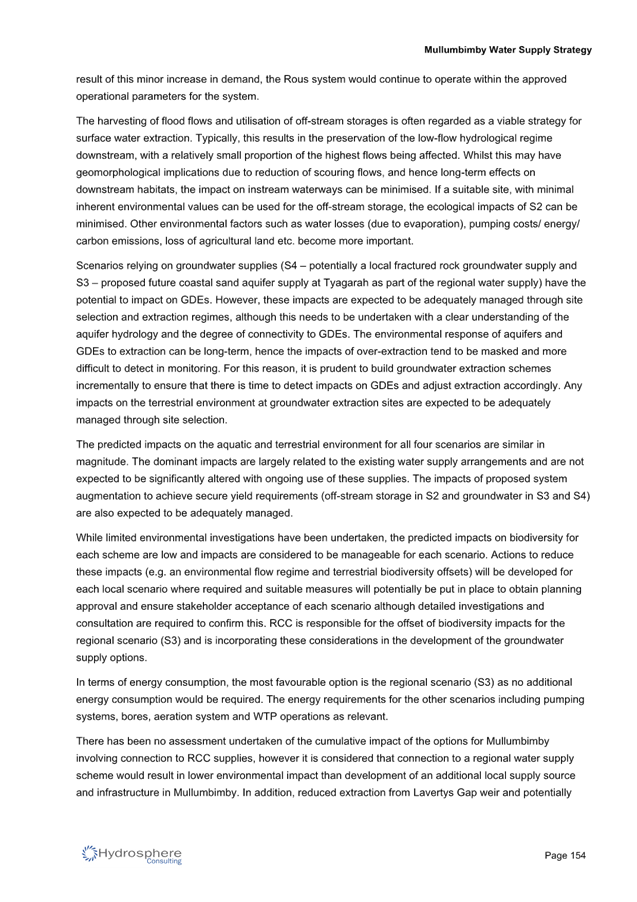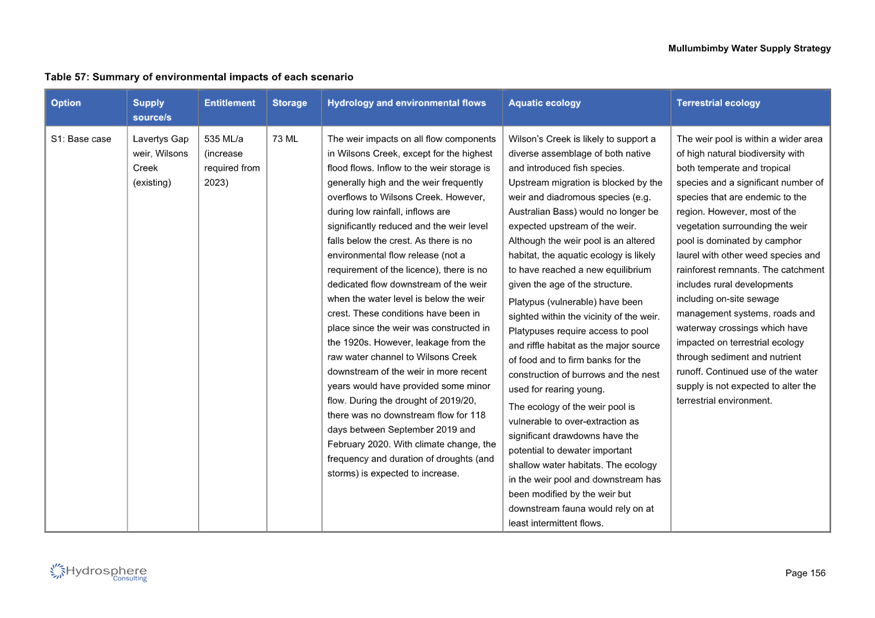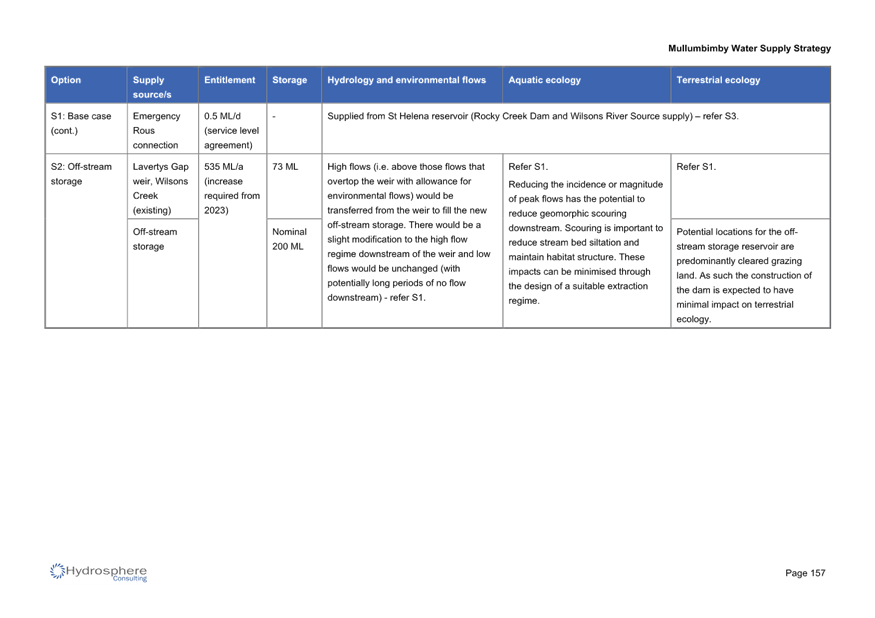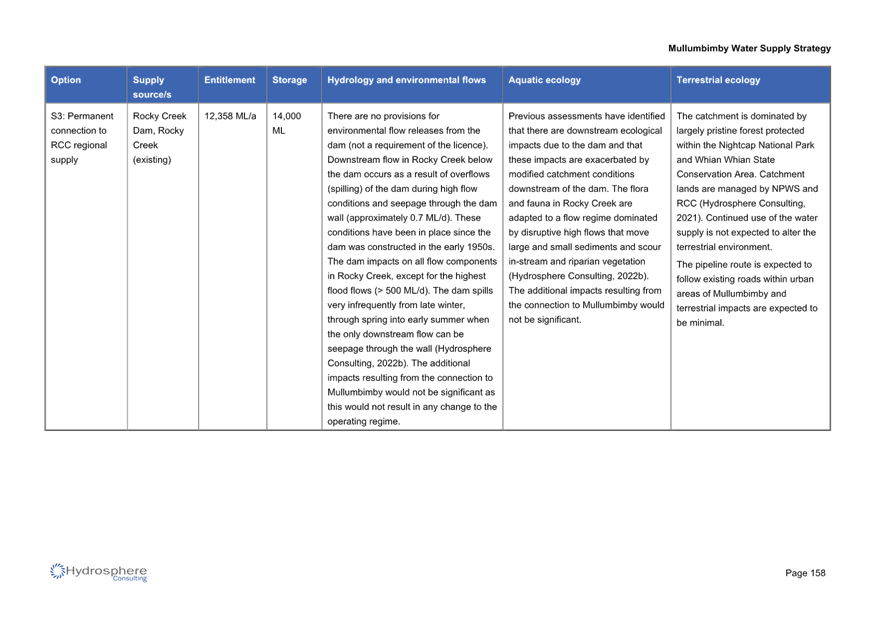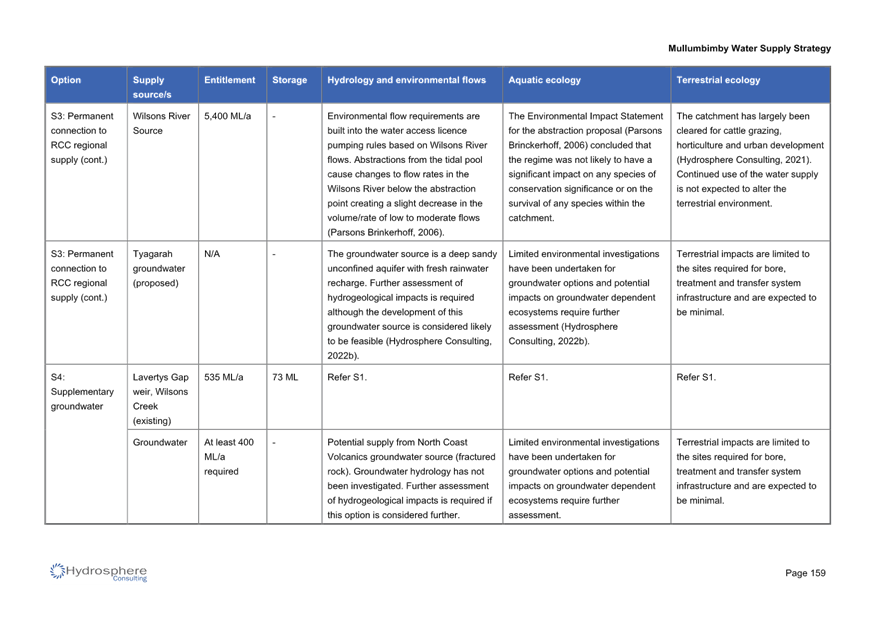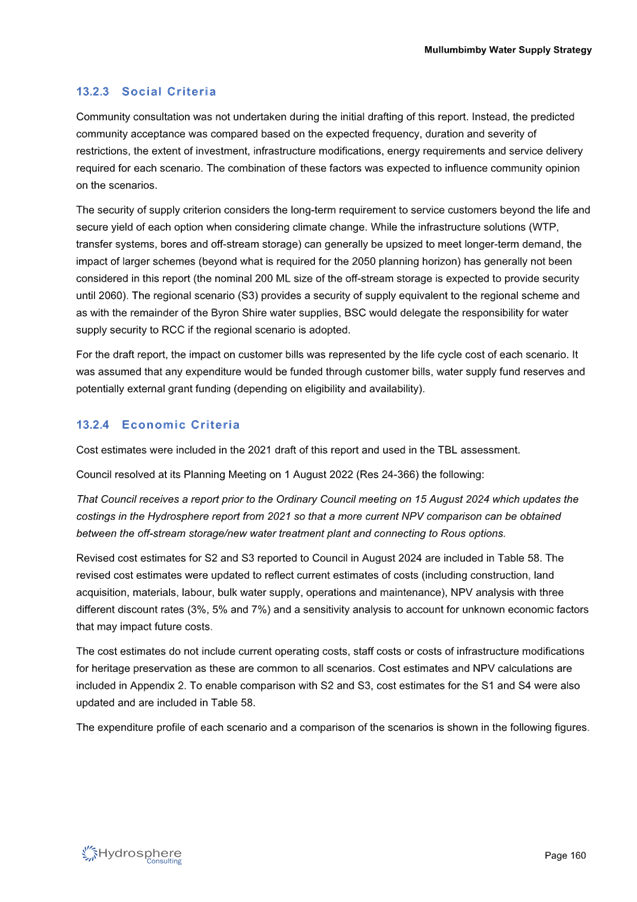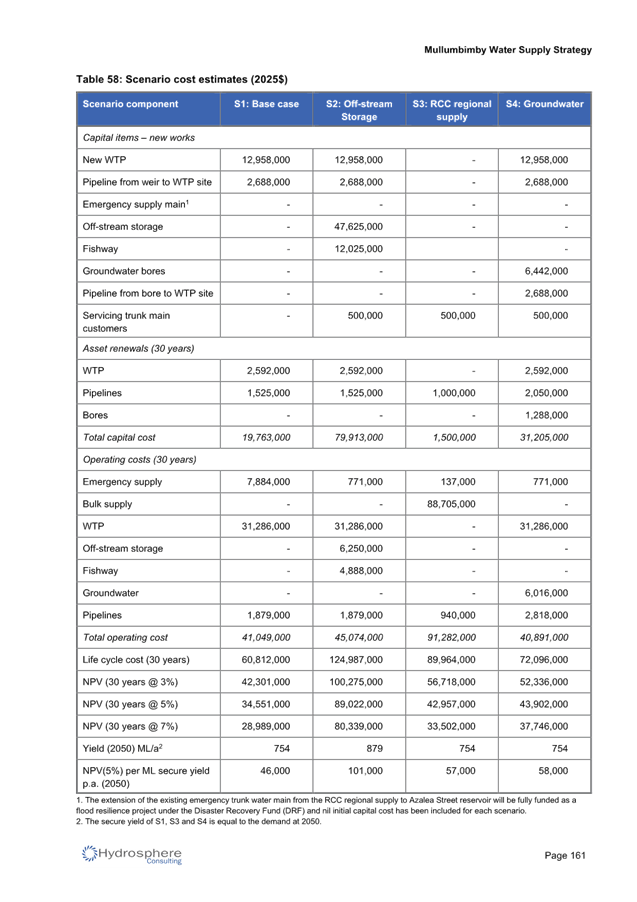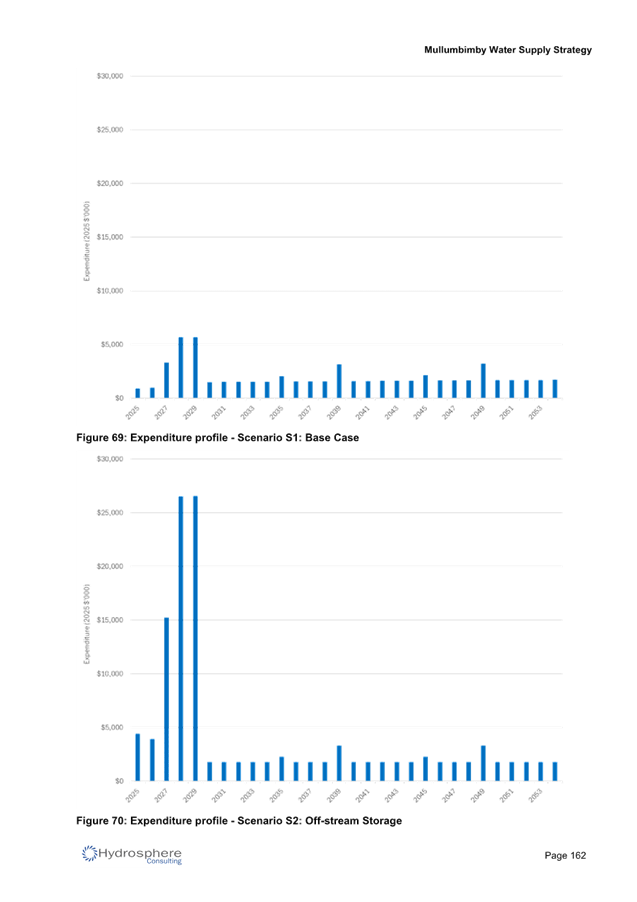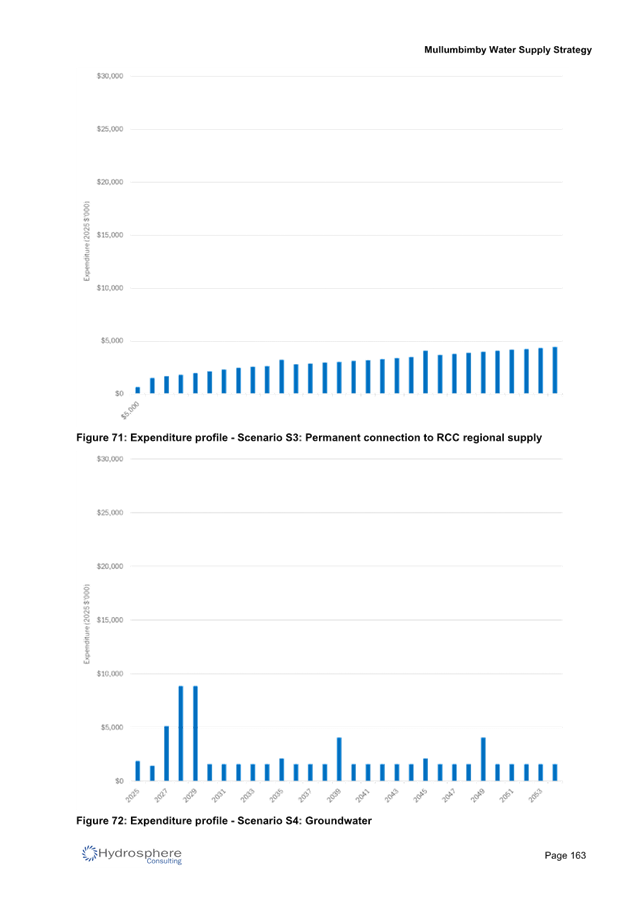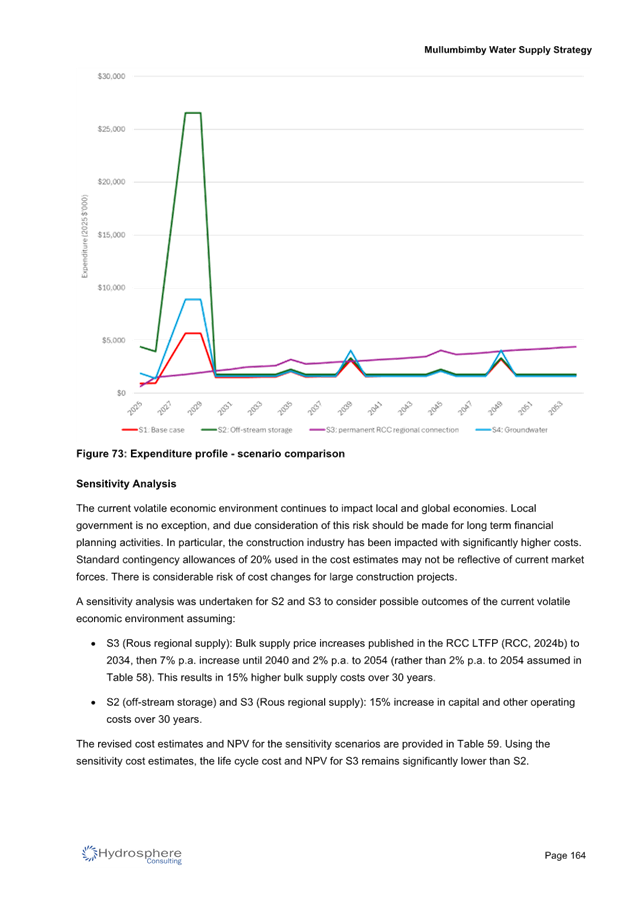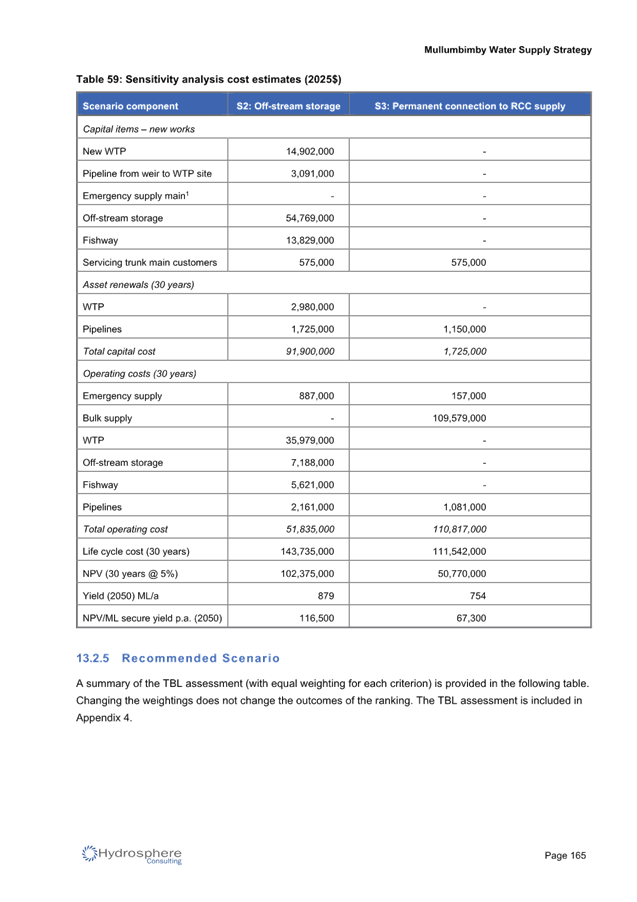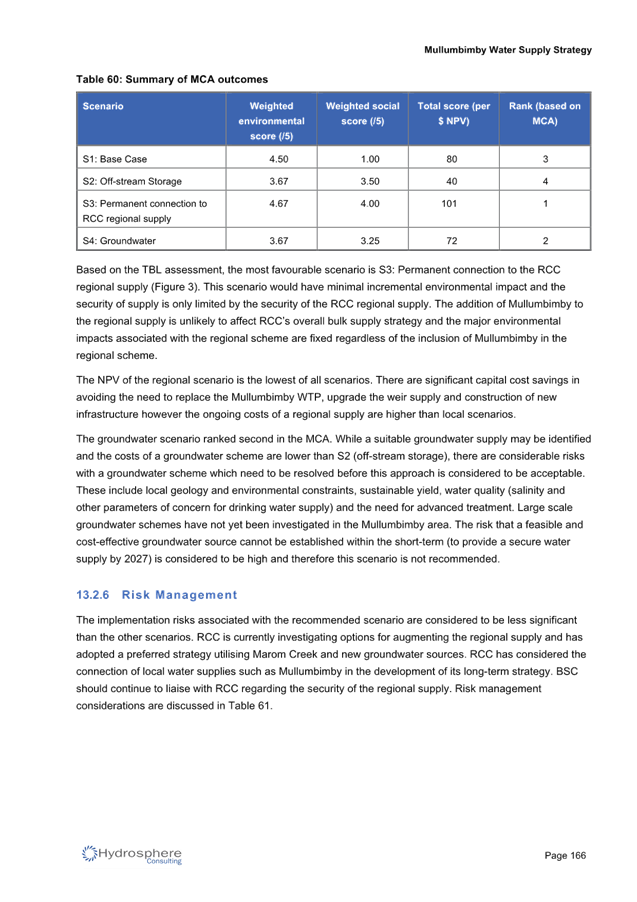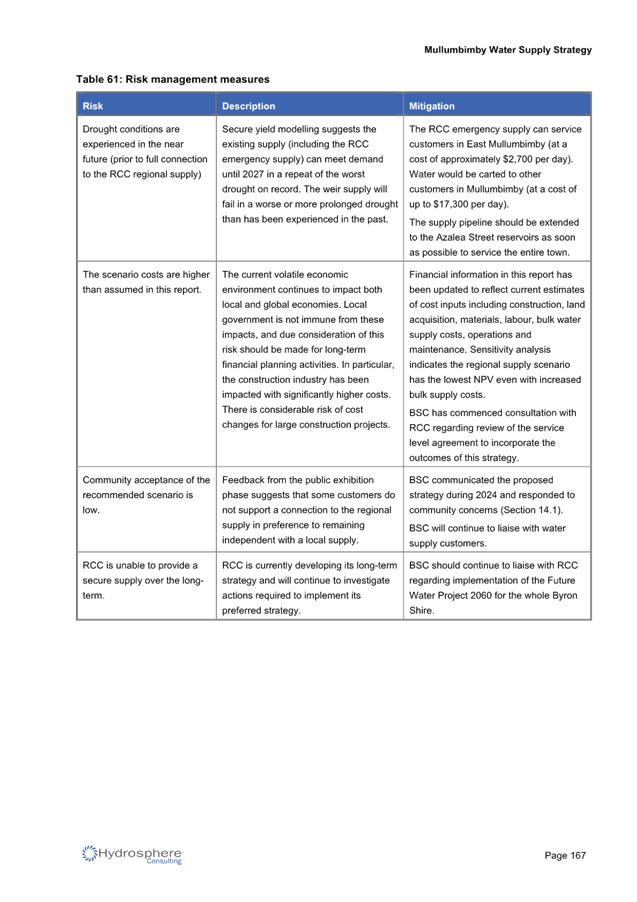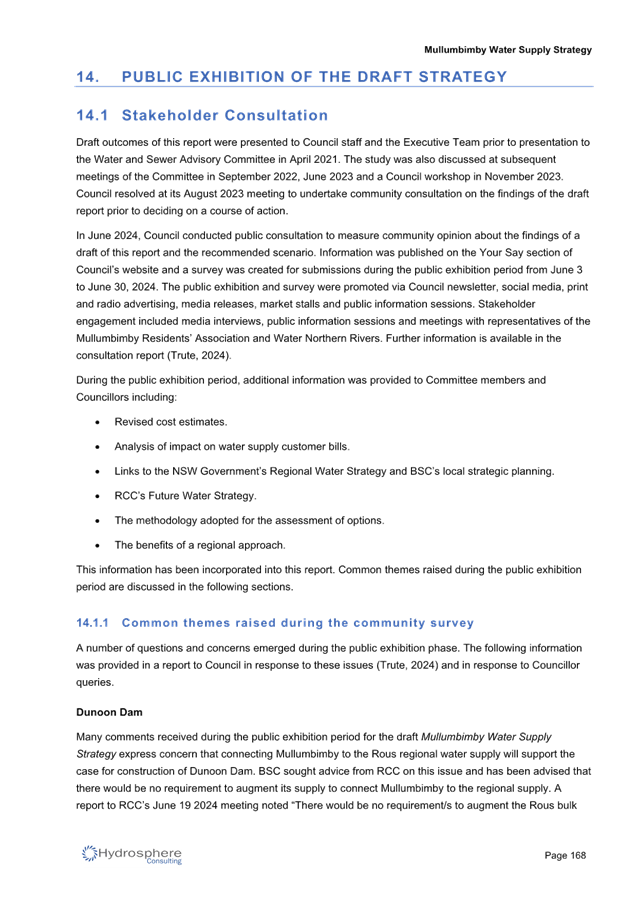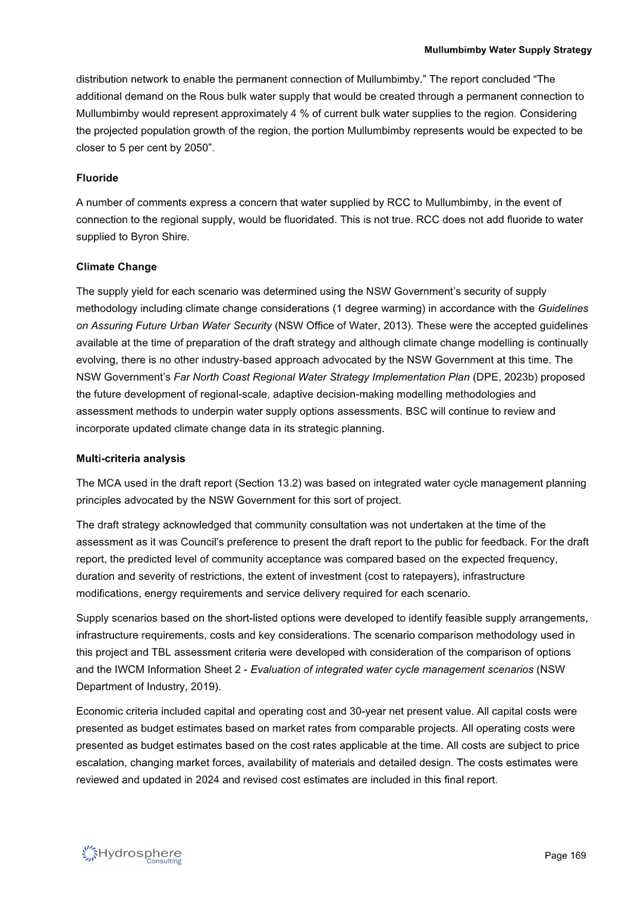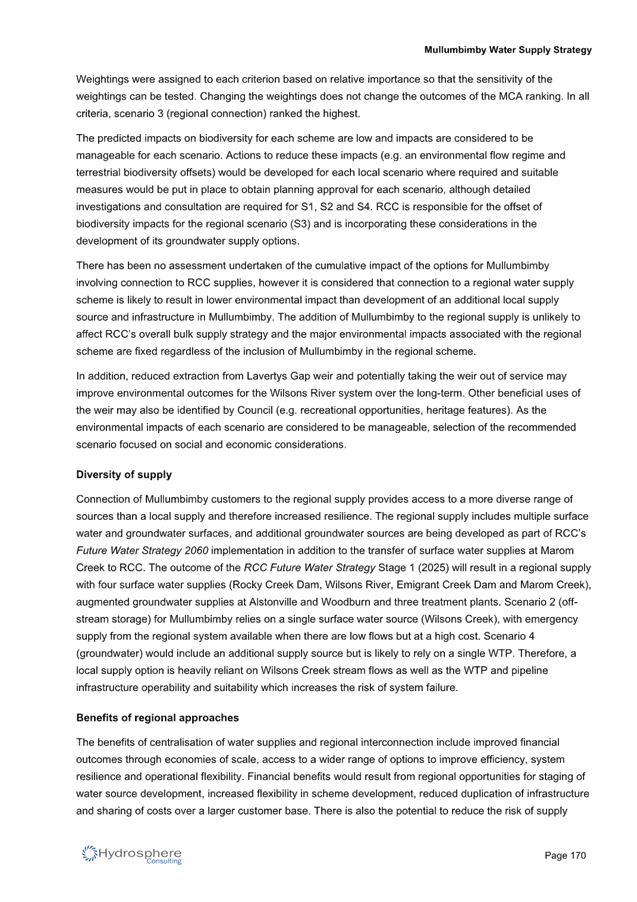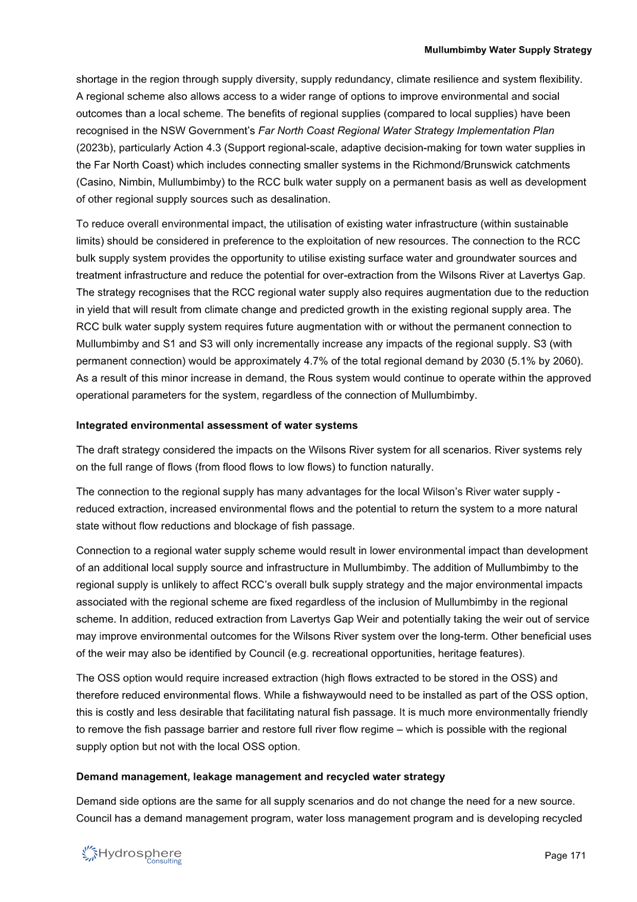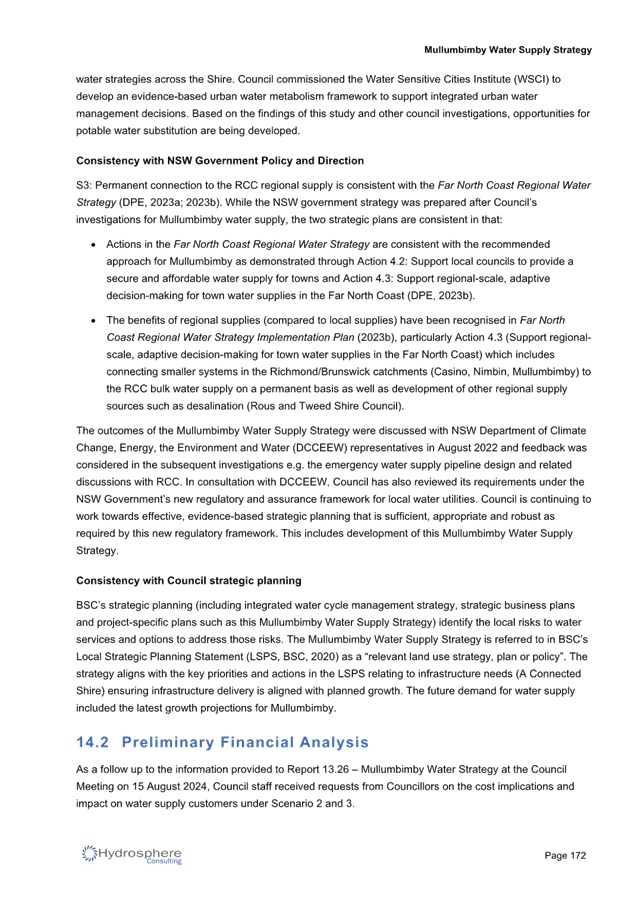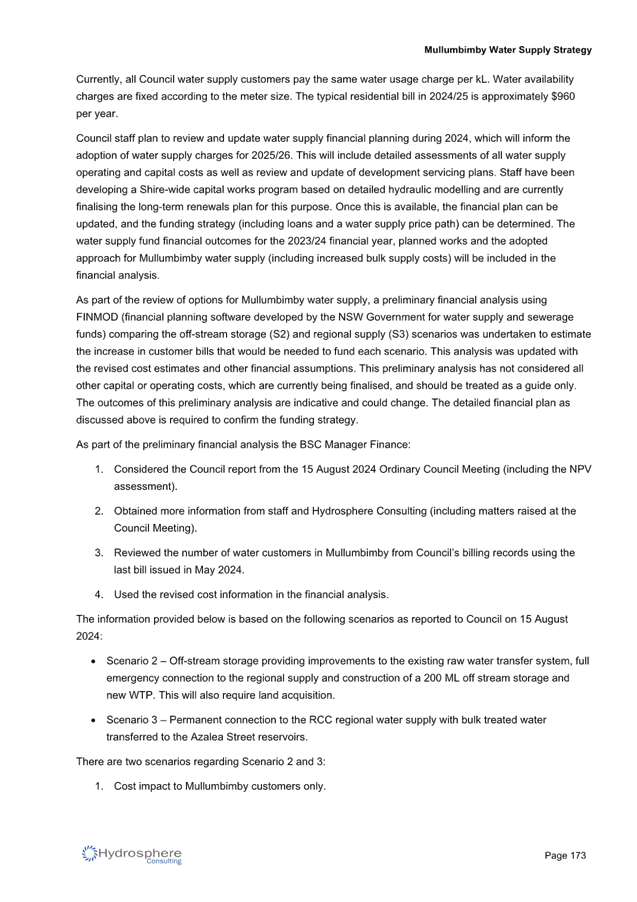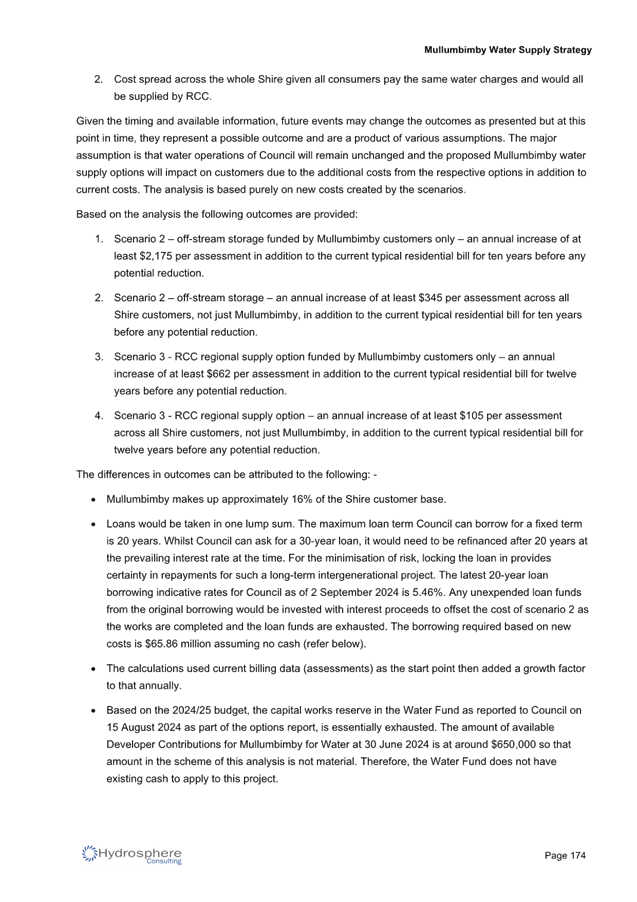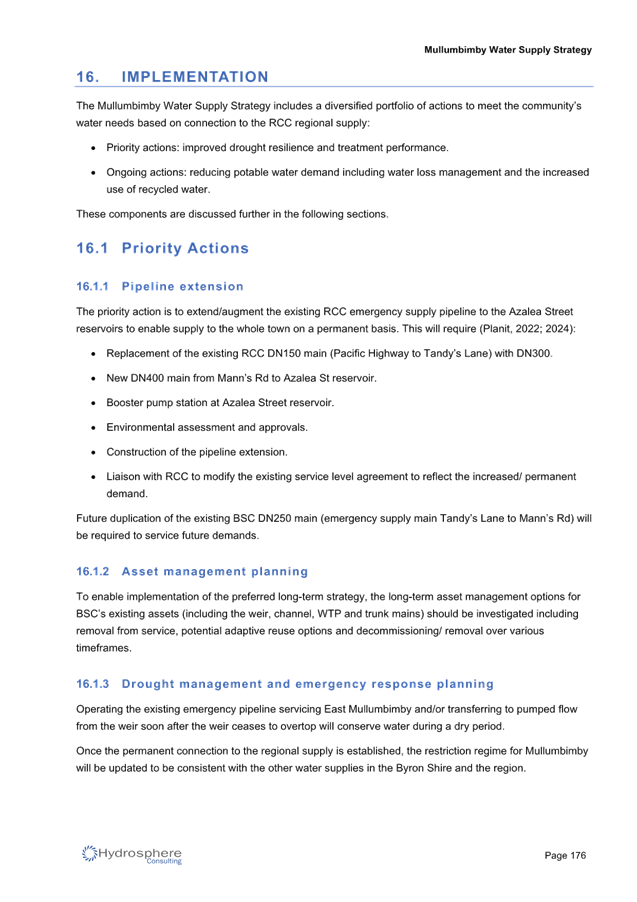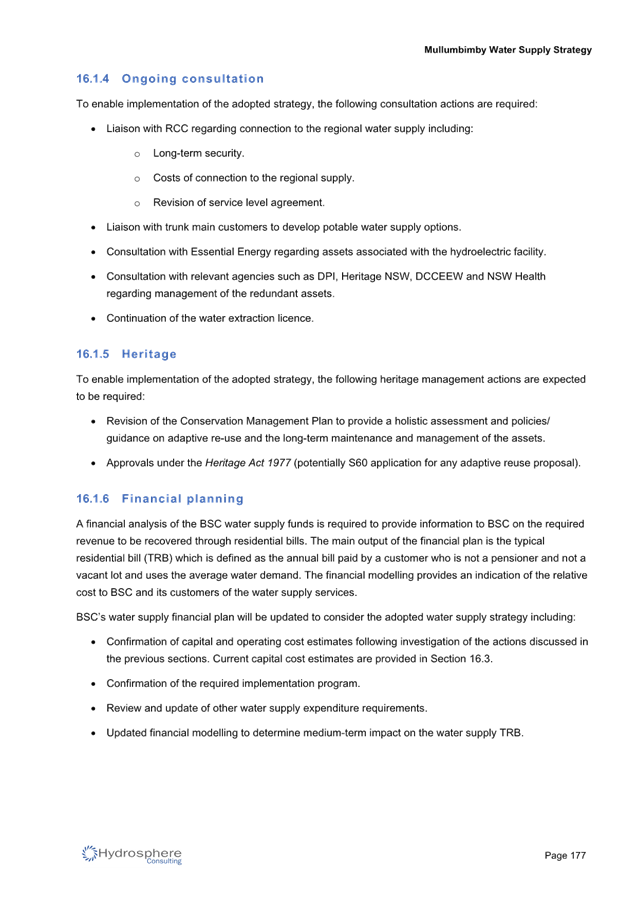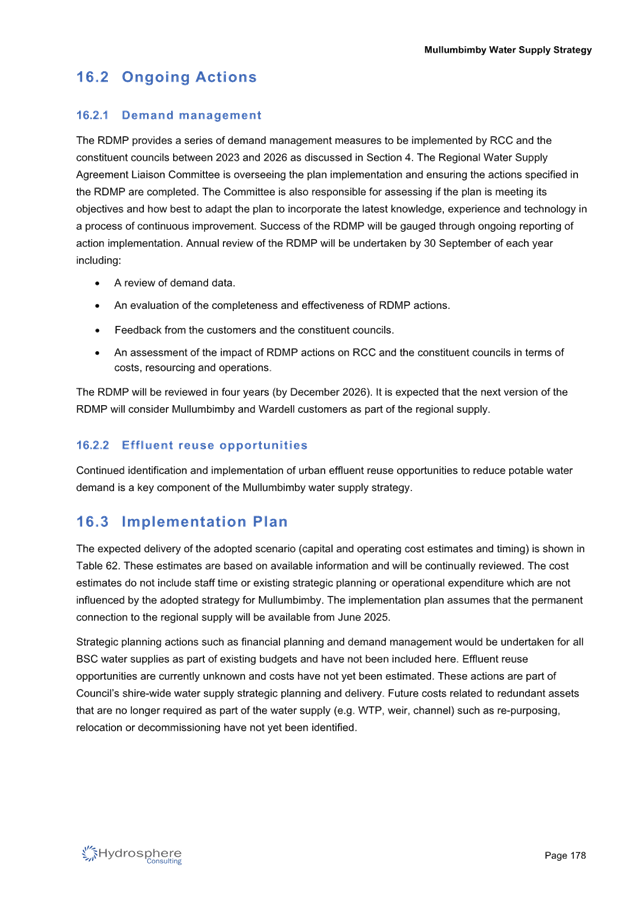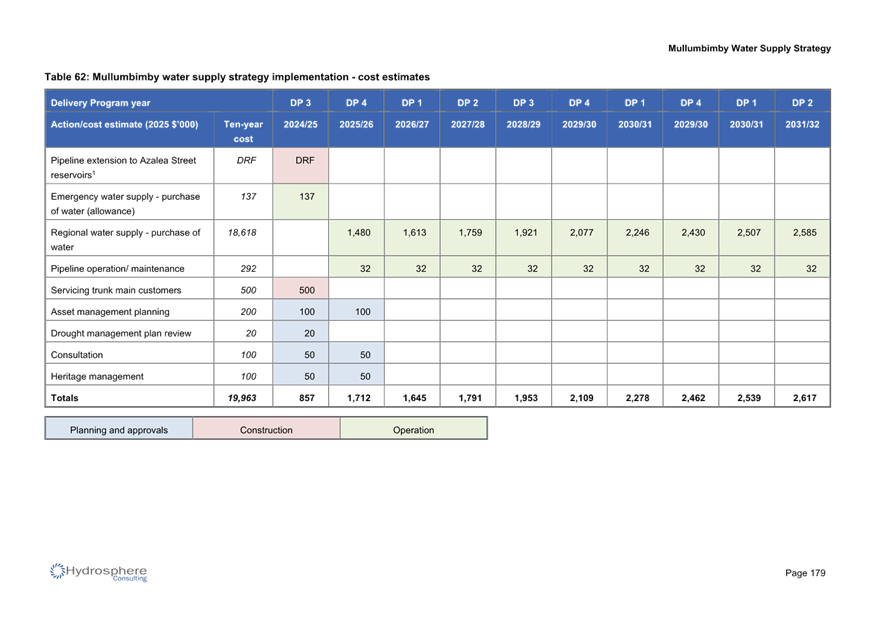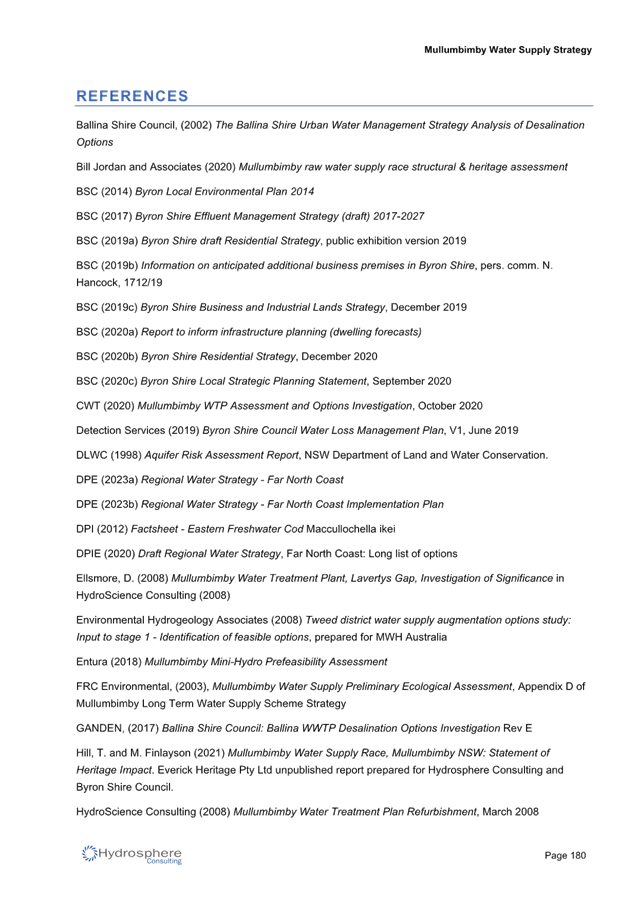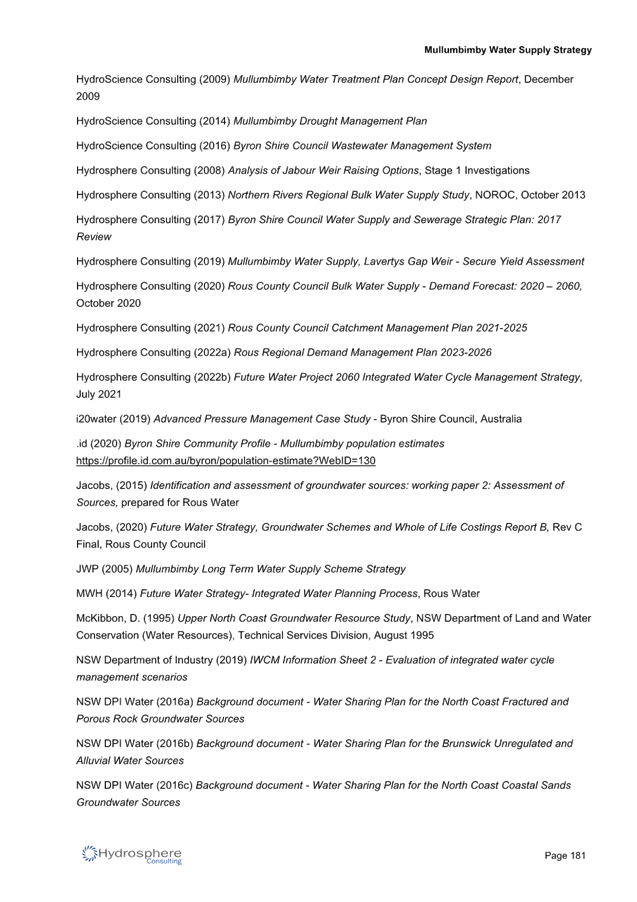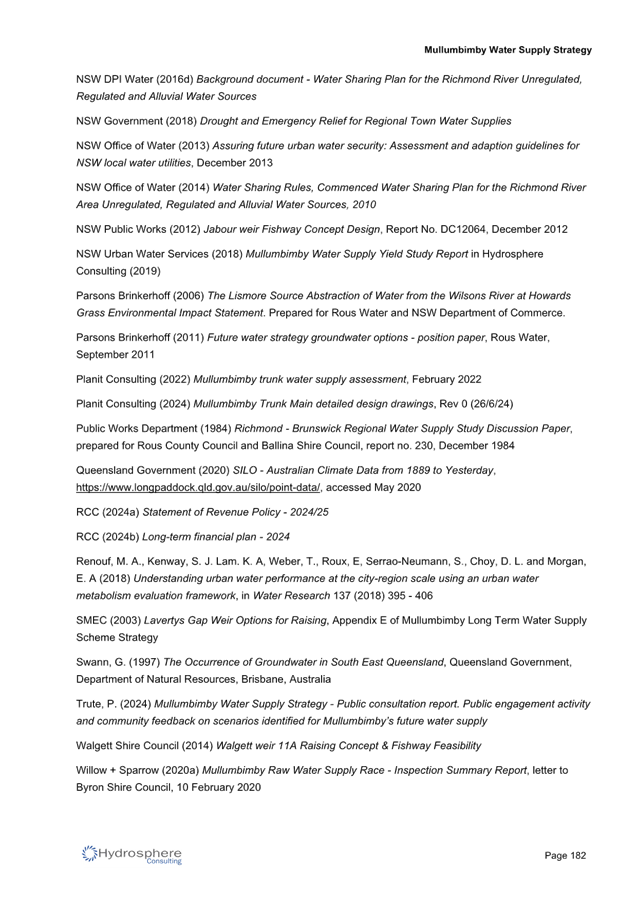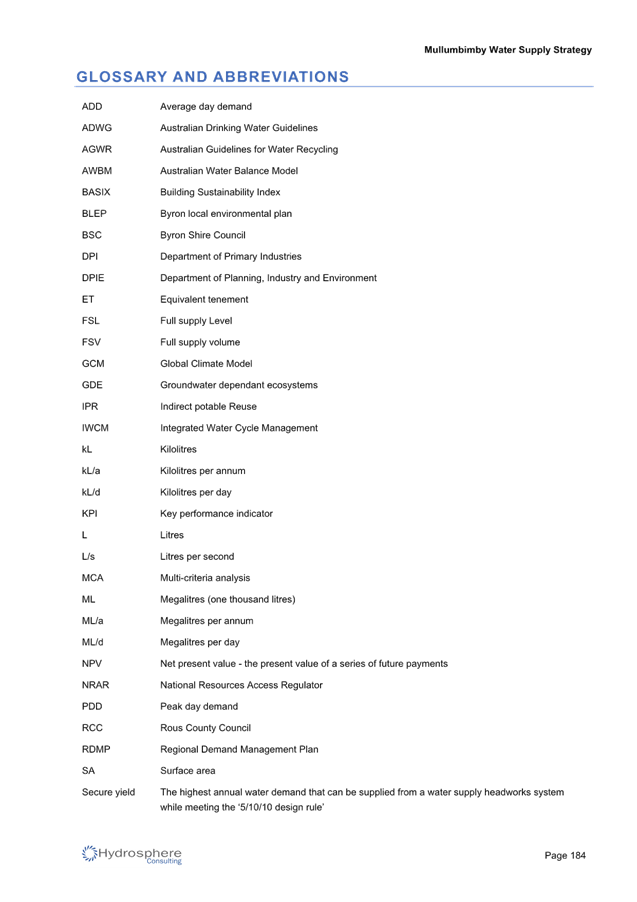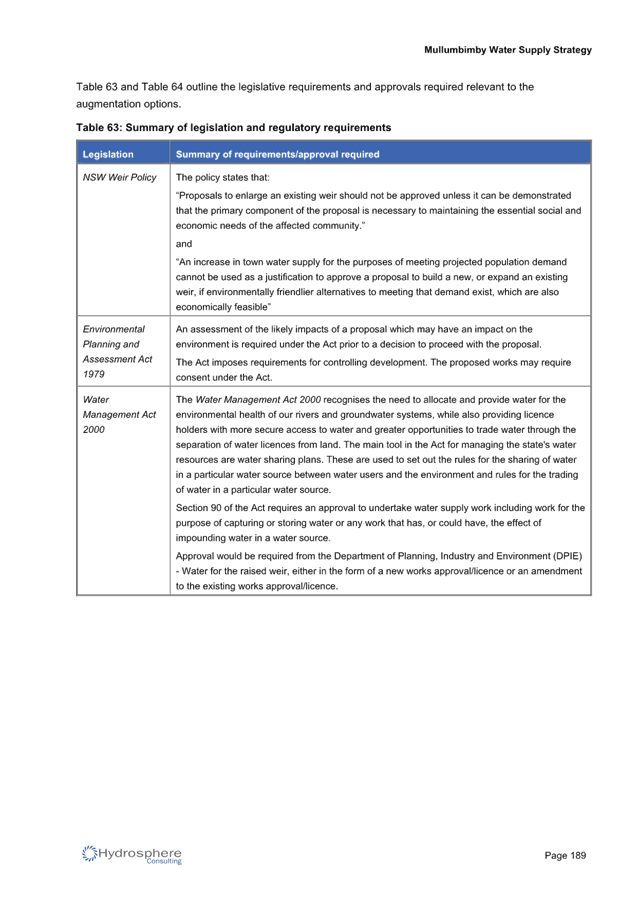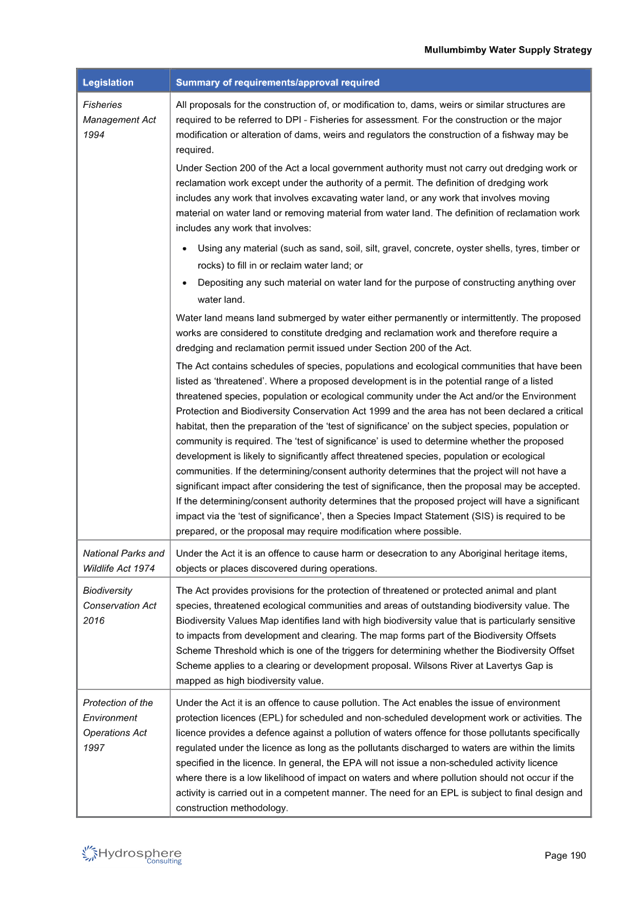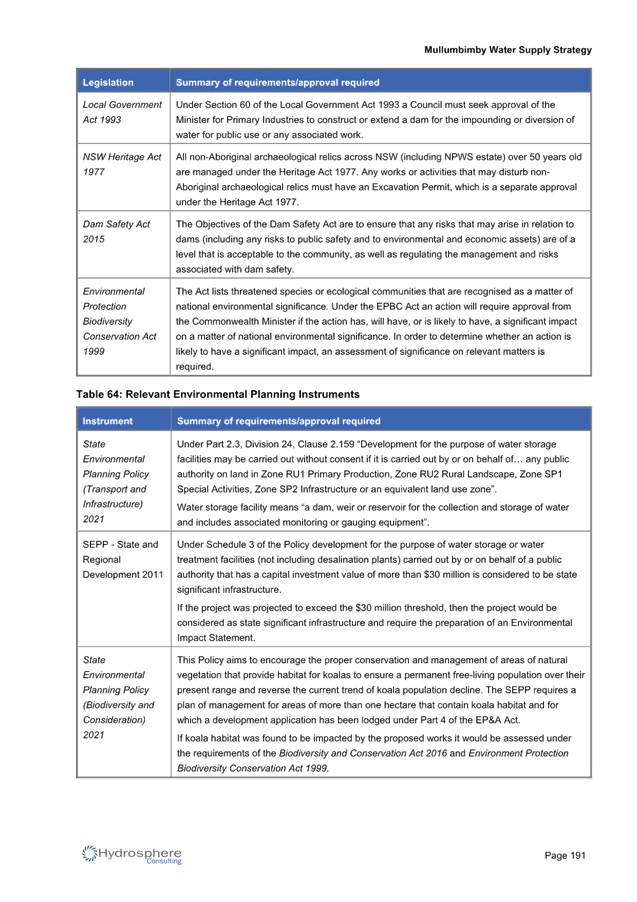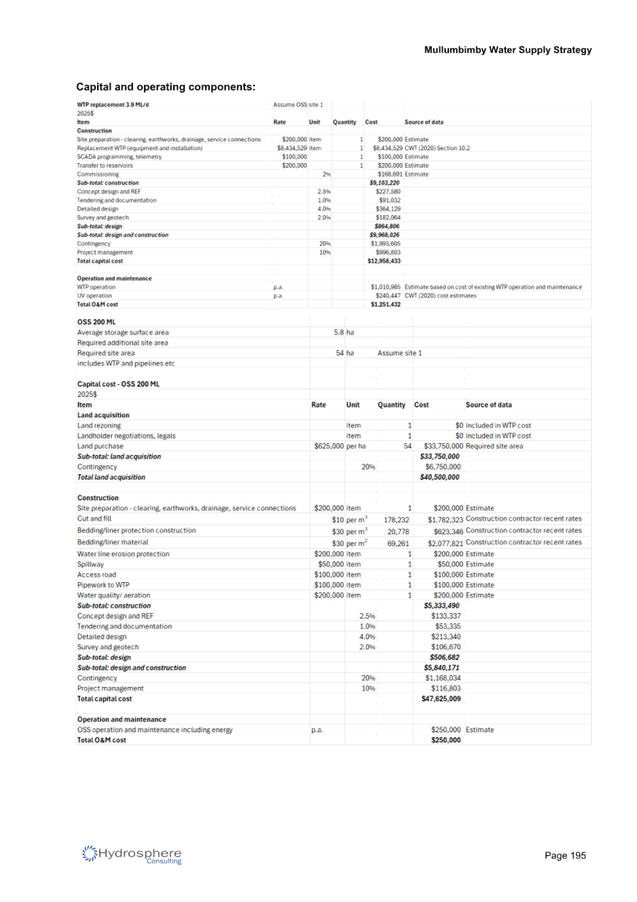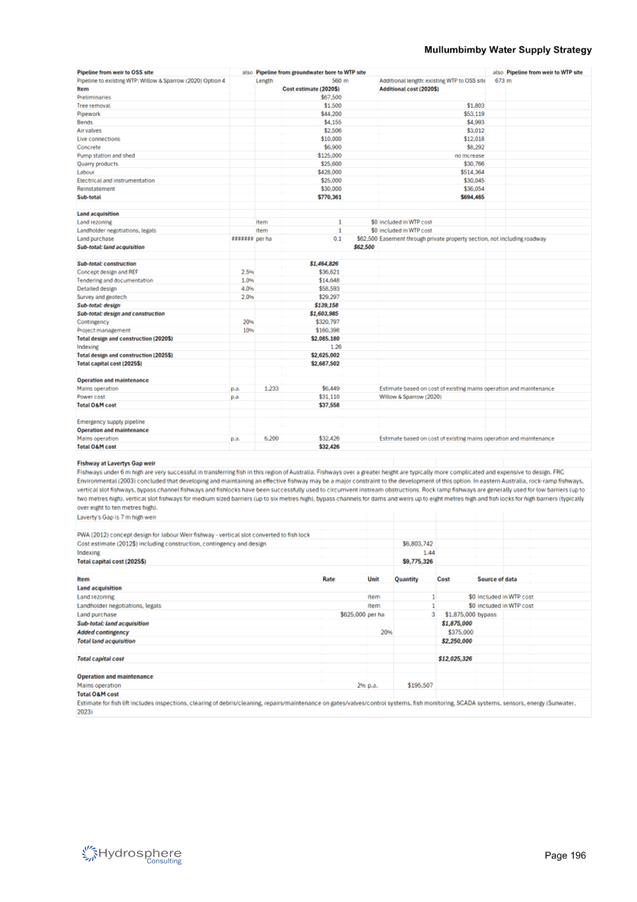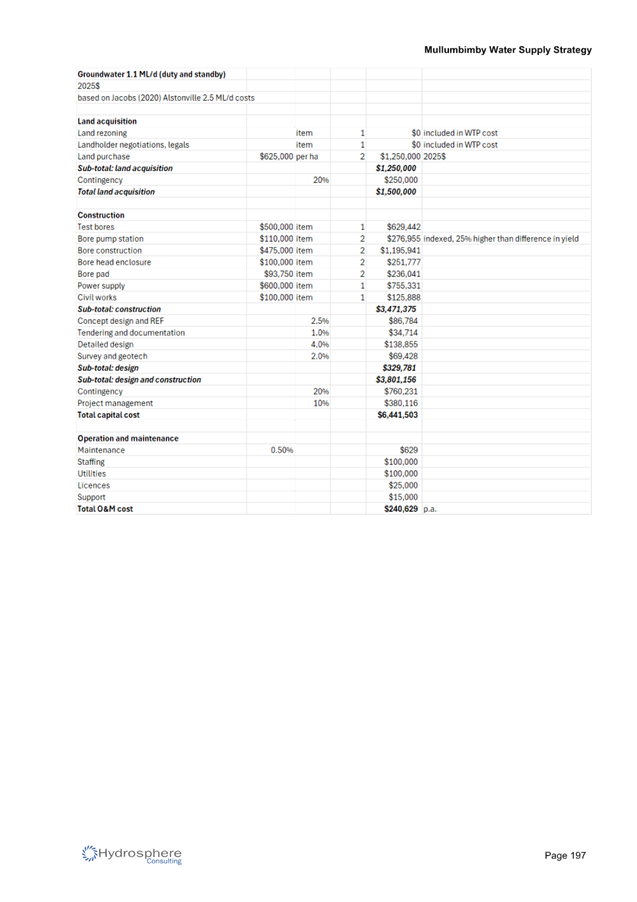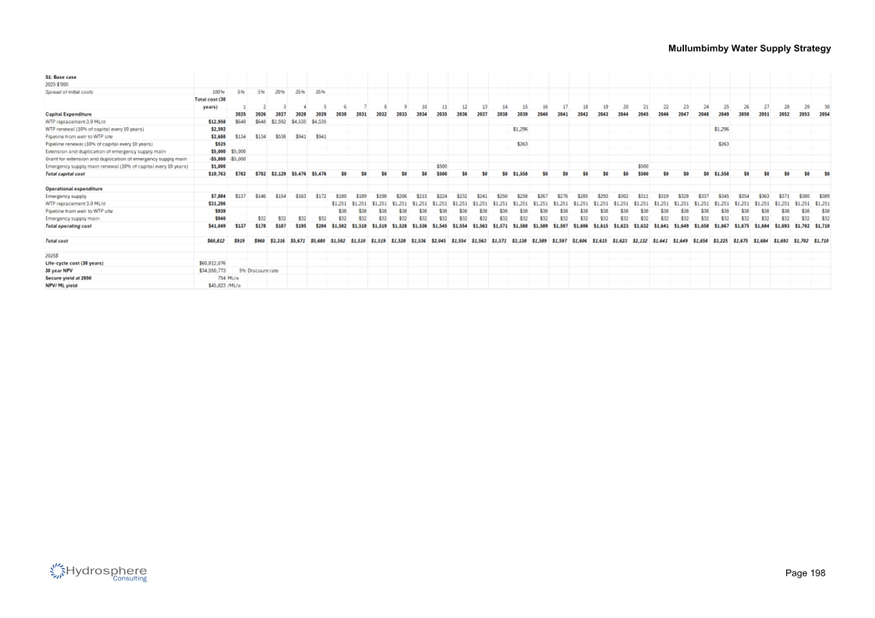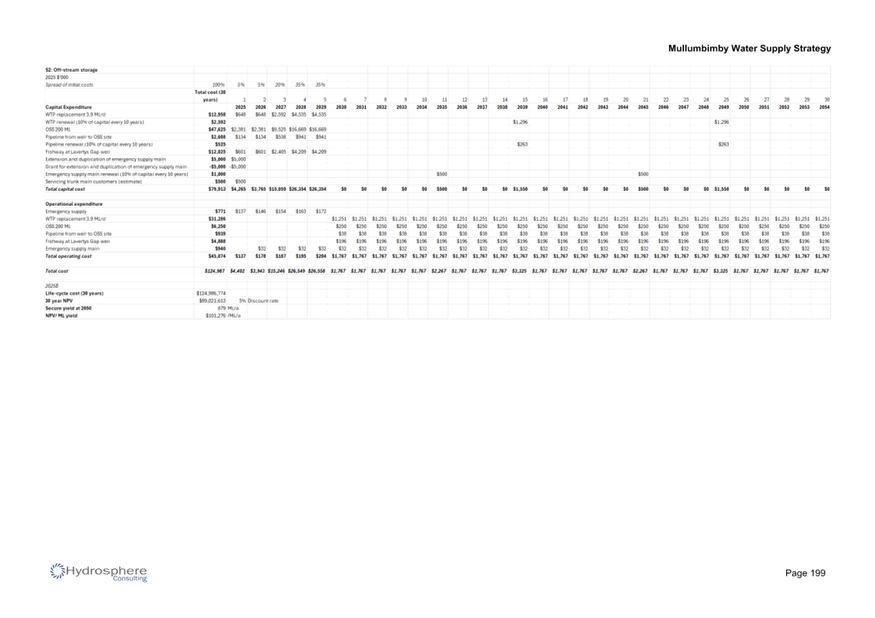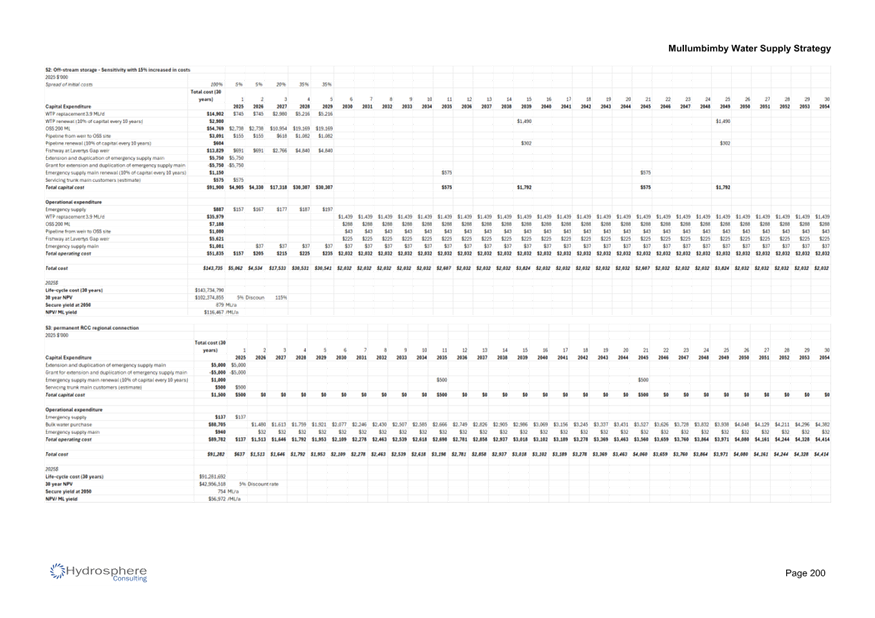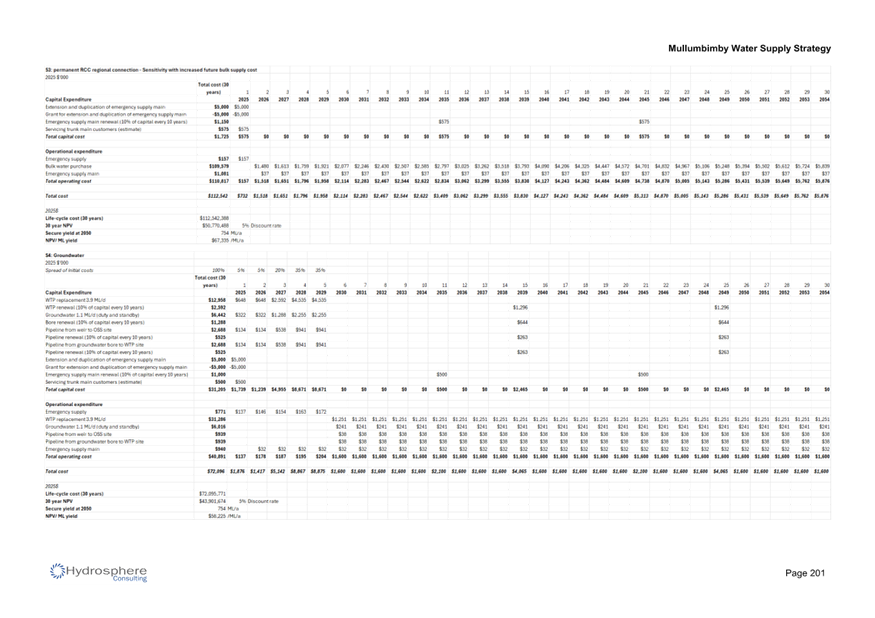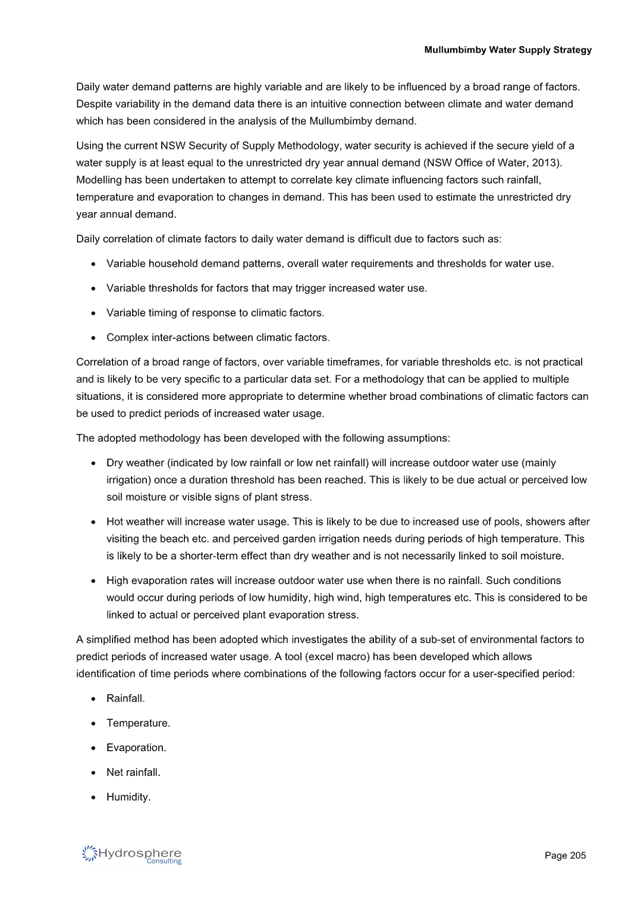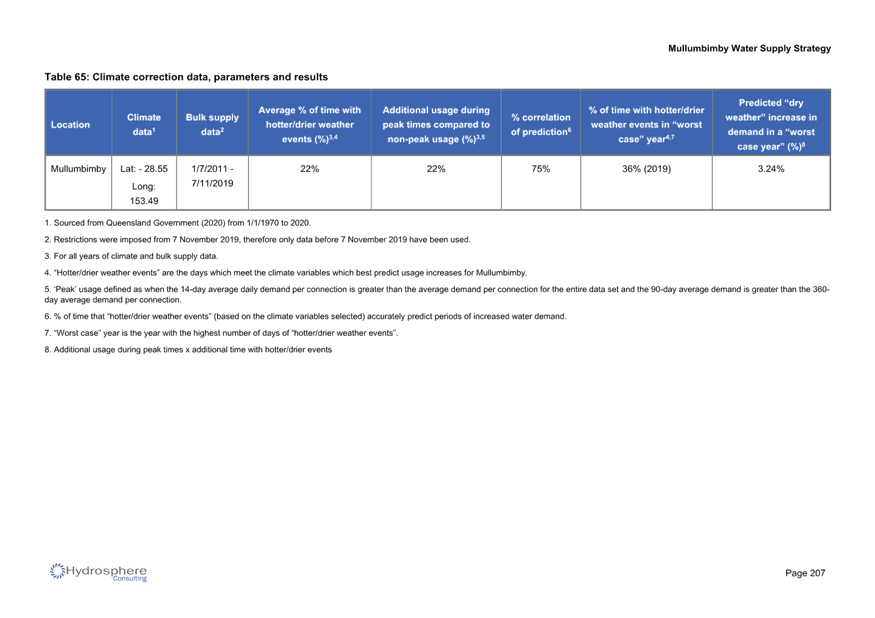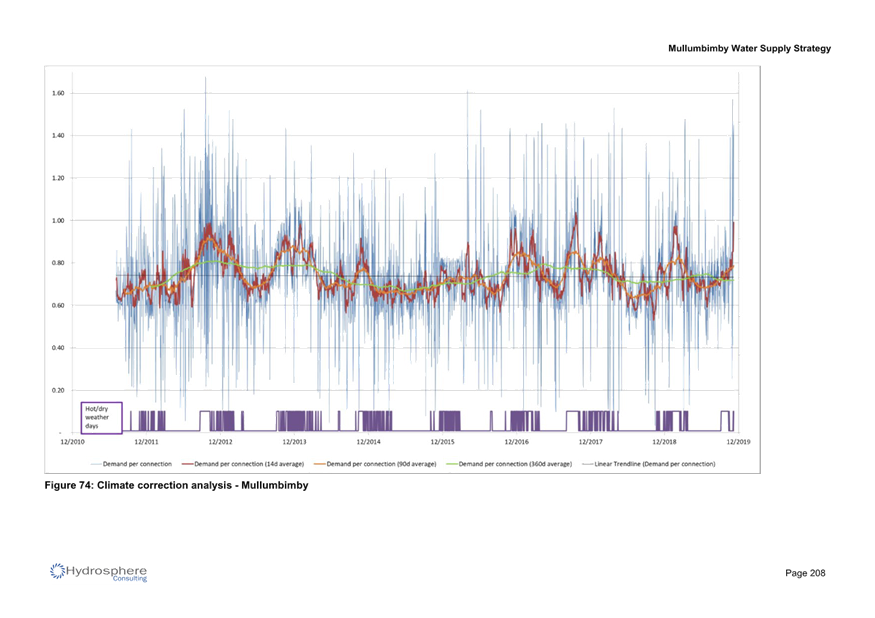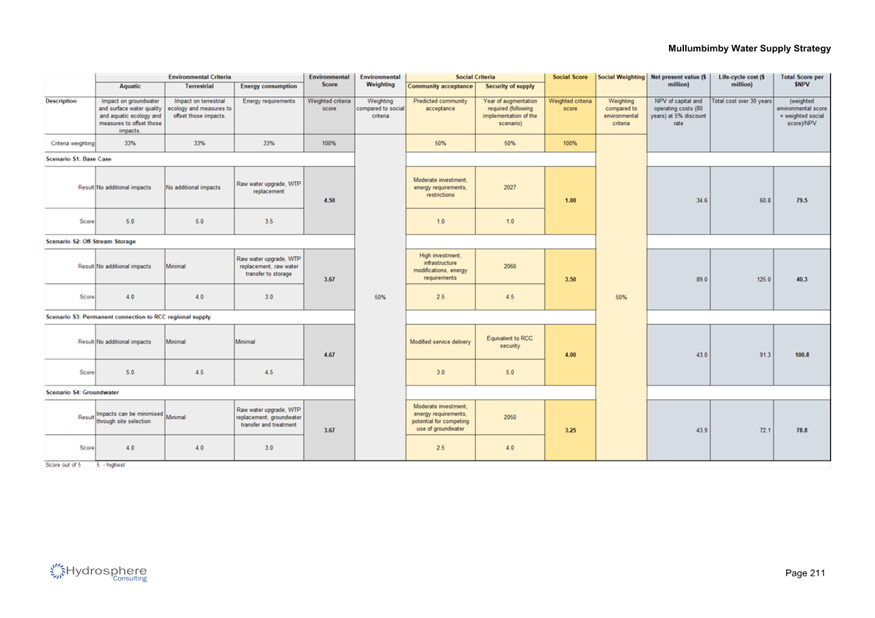Notice of Meeting
Water and Sewer Advisory Committee Meeting
A Water and Sewer
Advisory Committee Meeting of Byron Shire Council will be held as follows:
|
Venue
|
Conference Room, Station Street, Mullumbimby
|
|
Date
|
Thursday, 17 April 2025
|
|
Time
|
11:30 AM
|
Phil Holloway
Director Infrastructure
Services
I2025/490
Distributed
10/04/25

What is a “Conflict of Interests” - A conflict of
interests can be of two types:
Pecuniary - an interest that a person has in a matter because of a reasonable
likelihood or expectation of appreciable financial gain or loss to the person
or another person with whom the person is associated.
Non-pecuniary – a private or personal interest that a Council
official has that does not amount to a pecuniary interest as defined in the
Code of Conduct for Councillors (eg. A friendship, membership of an
association, society or trade union or involvement or interest in an activity
and may include an interest of a financial nature).
Remoteness – a person does not have a pecuniary interest in a matter
if the interest is so remote or insignificant that it could not reasonably be
regarded as likely to influence any decision the person might make in relation
to a matter or if the interest is of a kind specified in the Code of Conduct
for Councillors.
Who has a Pecuniary Interest? - a person has a pecuniary interest in a
matter if the pecuniary interest is the interest of the person, or another
person with whom the person is associated (see below).
Relatives, Partners - a person is taken to have a pecuniary
interest in a matter if:
·
The
person’s spouse or de facto partner or a relative of the person has a
pecuniary interest in the matter, or
·
The
person, or a nominee, partners or employer of the person, is a member of a
company or other body that has a pecuniary interest in the matter.
N.B. “Relative”, in relation to a person means any of the
following:
(a) the parent,
grandparent, brother, sister, uncle, aunt, nephew, niece, lineal descends or
adopted child of the person or of the person’s spouse;
(b) the spouse
or de facto partners of the person or of a person referred to in paragraph (a)
No Interest in the Matter - however, a person is not taken to have a
pecuniary interest in a matter:
·
If
the person is unaware of the relevant pecuniary interest of the spouse, de
facto partner, relative or company or other body, or
·
Just
because the person is a member of, or is employed by, the Council.
·
Just
because the person is a member of, or a delegate of the Council to, a company
or other body that has a pecuniary interest in the matter provided that the
person has no beneficial interest in any shares of the company or body.
Disclosure and participation in meetings
·
A
Councillor or a member of a Council Committee who has a pecuniary interest in
any matter with which the Council is concerned and who is present at a meeting
of the Council or Committee at which the matter is being considered must
disclose the nature of the interest to the meeting as soon as practicable.
·
The
Councillor or member must not be present at, or in sight of, the meeting of the
Council or Committee:
(a) at
any time during which the matter is being considered or discussed by the
Council or Committee, or
(b) at
any time during which the Council or Committee is voting on any question in
relation to the matter.
No Knowledge - a person does not breach this Clause if the person did
not know and could not reasonably be expected to have known that the matter
under consideration at the meeting was a matter in which he or she had a
pecuniary interest.
Non-pecuniary Interests - Must be disclosed in meetings.
There are a broad range of options available for managing conflicts &
the option chosen will depend on an assessment of the circumstances of the
matter, the nature of the interest and the significance of the issue being
dealt with. Non-pecuniary conflicts of interests must be dealt with in at
least one of the following ways:
·
It
may be appropriate that no action be taken where the potential for conflict is
minimal. However, Councillors should consider providing an explanation of
why they consider a conflict does not exist.
·
Limit
involvement if practical (eg. Participate in discussion but not in decision
making or vice-versa). Care needs to be taken when exercising this
option.
·
Remove
the source of the conflict (eg. Relinquishing or divesting the personal
interest that creates the conflict)
·
Have
no involvement by absenting yourself from and not taking part in any debate or
voting on the issue as of the provisions in the Code of Conduct (particularly
if you have a significant non-pecuniary interest)
Committee members are reminded that they should declare and manage all
conflicts of interest in respect of any matter on this Agenda, in accordance
with the Code of Conduct.
RECORDING OF VOTING ON PLANNING MATTERS
Clause 375A of the Local Government Act
1993 – Recording of voting on planning matters
(1) In this section, planning
decision means a decision made in the exercise of a function of a council
under the Environmental Planning and Assessment Act 1979:
(a) including a decision relating to a development
application, an environmental planning instrument, a development control plan
or a development contribution plan under that Act, but
(b) not including the making of an order under that Act.
(2) The general manager is required to keep a register
containing, for each planning decision made at a meeting of the council or a
council committee, the names of the councillors who supported the decision and
the names of any councillors who opposed (or are taken to have opposed) the
decision.
(3) For the purpose of maintaining the register, a division
is required to be called whenever a motion for a planning decision is put at a
meeting of the council or a council committee.
(4) Each decision recorded in the register is to be described
in the register or identified in a manner that enables the description to be
obtained from another publicly available document and is to include the
information required by the regulations.
(5) This section extends to a meeting that is closed to the
public.
OATH AND AFFIRMATION FOR COUNCILLORS
Councillors are
reminded of the oath of office or affirmation of office made at or before their
first meeting of the council in accordance with Clause 233A of the Local
Government Act 1993. This includes undertaking the duties of the office of
councillor in the best interests of the people of Byron Shire and the Byron
Shire Council and faithfully and impartially carrying out the functions,
powers, authorities and discretions vested under the Act or any other Act
to the best of one’s ability and judgment.
BYRON SHIRE COUNCIL
BUSINESS OF MEETING
1. Apologies
2. Declarations
of Interest – Pecuniary and Non-Pecuniary
3. Minutes from Previous
Meetings
3.1 Adoption
of minutes from Previous Meeting.............................................................. 6
4. Staff Reports
Corporate and Community
Services
4.1 Integrated
Planning and Reporting.............................................................................. 6
Infrastructure Services
4.2 Mullumbimby
water supply strategy - High-level project plan................................. 6
4.3 Byron
STP Wetlands Monitoring Report.................................................................... 6
5. Late Reports
6. For Information Only
6.1 Infrastructure
Services Utilities Monthly Status Report December 2024 - February 2025.................................................................................................................................. 6
BYRON SHIRE COUNCIL
Minutes from Previous Meetings 3.1
Minutes from Previous Meetings
Report No. 3.1 Adoption of minutes from Previous Meeting
Directorate: Infrastructure Services
File No: I2025/480
RECOMMENDATION:
That the minutes of the Water and Sewer Advisory
Committee Meeting held on 19 July 2024 be confirmed.
Attachments:
1 Minutes
19/07/2024 Water and Sewer Advisory Committee Extraordinary, I2024/1042 ,
page 6⇩ 
Report
The attachment to this report provides the minutes of the
Water and Sewer Advisory Committee Meeting of 19 July 2024 .
Report to Council
The minutes were reported to Council on
Comments
In accordance with the Committee Recommendations, Council
resolved the following:
|
24-421
|
Resolved that Council does not adopt the
following Recommendation:
Report No. 4.1 Mullumbimby Water Supply Strategy Public
Consultation Report
Committee Recommendation 4.1.1
That Council:
1. Publicly
thanks the community for its participation in making more than 433 Your-Say
submissions during June 2024 on Mullumbimby's future water supply;
2. Acknowledges
that 89% of 411 valid Your-Say respondents oppose abandoning the Wilsons
Creek source (Lavertys Gap), while 6% are neutral and 5% support;
3. Notes
that Hydrosphere's report "Mullumbimby Water Supply Strategy" of
December 2021 does not investigate Option 2 (adding off-stream storage and
retaining the Wilsons Creek source) to the extent suggested in Council's
Resolution 23-120 and that it assesses Option 3 (Rous only) without Dunoon
Dam which is now included in Rous's forward water source planning;
4. Notes
the following extract from the North Coast Enabling Regional Adaptation,
North Coast Region Report (NSW Office of Environment and Heritage, 2019)
which states on page 15:
“Under
a transformed system for infrastructure [,] water systems are smaller,
localised and decentralised with multiple redundancies providing tailored and
integrated solutions”
5. Proceeds
with the investigations previously outlined in Parts 7 and 8 of Resolution
23-120 with some additions in 8b and 8c, namely:
6. Investigates
a strategy for Mullumbimby’s long term water supply based on the
following concept:
a) Lavertys Gap as the source
during flows in excess of environmental requirements;
b) water stored off-stream
between the source and Mullumbimby;
c) water treated at a new
location between the storage and Mullumbimby;
d) water delivered to
Mullumbimby and possibly beyond; and
e) maximising demand
management, including the harvesting of roof water.
7. Includes
in this investigation:
a) the topography of the
terrain between Lavertys Gap and Mullumbimby, to identify potential dam
sites;
b) the hydrology of Wilsons
Creek and its capacity to supply, including
(i)
seasonality,
(ii)
establishing environmental flows for future EPA licensing;
c) the impact of climate change
on supply and on demand (using up-to-date CC data and methodologies in the
pilot phase for local water supply through DPE, and applied in Regional Water
Strategies);
d) infrastructure needs
including offtake, storage, treatment and linkages to the town’s
reservoirs;
e) environmental assessments
for the creation and operation of that infrastructure, including greenhouse
gas emissions;
f) assessment of the weir
at Lavertys Gap including
(i)
structural integrity;
(ii)
means of creating fish passage; and
(iii)
how this proposal enhances its heritage and preservation; and
g) economic assessment.
8. Notes
the successful upgrade to Kyogle’s water supply which included off
stream storage and creation of fish passage on the existing weir in the
Richmond River.
9. Supports
Council consulting with landowners of properties currently supplied from the
pressure line between the Water Treatment Plant at Lavertys Gap and the
reservoir near Azalea Street, by:
a) Listening to their wishes,
and
b) Considering outcomes
including a reticulation pipeline returning from Azalea Street reservoir to
those properties.
|
BYRON SHIRE COUNCIL
Minutes
from Previous Meetings 3.1 - Attachment 1






BYRON SHIRE COUNCIL
Staff Reports - Corporate and Community Services 4.1
Staff Reports - Corporate and Community Services
Report No. 4.1 Integrated
Planning and Reporting
Directorate: Corporate
and Community Services
Report Author: Amber
Evans Crane, Corporate Planning and Improvement Coordinator
File No: I2025/481
Summary:
This report provides an overview of Council’s
Integrated Planning and Reporting Framework and invites discussion on priority
areas for inclusion in Council’s delivery program.
RECOMMENDATION:
That the Water and Sewer Advisory Committee:
1. Notes Council’s
Integrated Planning and Reporting Framework;
2. Notes
Council’s priorities as identified by Councillors for the 2025 –
2029 and Delivery Program
Background to Integrative Planning and
Reporting (IP&R)
The Integrated Planning and
Reporting Framework in NSW requires all councils to adopt a suite of strategic
plans. These long-term plans provide transparency and make it possible for
Council to plan in a manner which ensures that community needs and priorities
are responded to well into the future. Council also has a suite of strategies,
plans and policies which help inform operations and decision making, and these
policies are adhered to in alignment with the Integrated Planning and Reporting
Framework.
The central IP&R
documents are outlined in more detail:
10 Year Community Strategic Plan
Leading the Council’s planning hierarchy, the
Community Strategic Plan (CSP) captures the community’s vision,
aspirations, and expectations for the future. It identifies key social,
economic, and environmental priorities and long term strategies to achieve
these goals over the next 10 years.
The CSP outlines the vision, community objectives and
supporting strategies which will guide Council’s long-term decision
making. Robust engagement with the community about their desires and
expectations has guided the long-term future planning to meet the needs and
aspirations of the community.
10 Year Resourcing Strategy
The resourcing strategy addresses the sustainable long term
financial, asset management, and workforce planning requirements. This is the
point where Council assists the community by sorting out who is responsible for
what, in terms of the issues identified in the Community Strategic Plan.
4 Year Delivery Program
The delivery program translates the community strategic plan
goals into actions. It is Council’s commitment to the community,
outlining what it intends to do toward achieving the goals of the community
strategic plan during its term of office. The Delivery Program is the single
point of reference for all principal activities undertaken by Council. All
plans, projects, activities, and funding allocations must be directly linked to
the four-year delivery program.
Annual Operational Plan
The Delivery Program is supported by an annual Operational
Plan which details the individual projects and activities that will be
undertaken each year to achieve the commitments of the Delivery Program. The
Operational Plan is supported by a detailed budget and a statement of revenue
policy, which also sets the fees and charges for that year.
Advisory Committee Input into IP&R
The key IP&R documents
described in the Background section are in the process of review as is the
requirement following a local government election.
The current Community Strategic Plan (CSP) 2032 has been
reviewed and the next iteration, the CSP 2035, was placed on public exhibition
at the 28 November 2024 Ordinary Council meeting with submissions open until 9
February 2025. The revised CSP will be presented back to Council for adoption
in May 2025. The draft can be found on Council’s website at
www.byron.nsw.gov.au/communityplan.
Adjacent to this, the Delivery
Program 2025 – 2029 and Operational Plan 2025/26 are being developed.
Both documents will be presented to Council in May 2025 and placed on public
exhibition for public feedback.
The four-year priorities recently
identified by Councillors for inclusion in the Delivery Plan 2025-2029 that
relate to the Committee include:
· Water
Supply
· Wastewater
Management
· Storm-water
· Water
Sensitive Urban Design
· Water
Security
Community Strategic Plan
and Operational Plan
|
CSP Objective
|
CSP Strategy
|
DP Action
|
Code
|
OP Activity
|
|
1:
Effective Leadership
|
1.1:
Enhance trust and accountability through open and transparent leadership
|
1.1.4:
Performance Measurement and Reporting - Embed a robust performance management
system through the development of an outcomes measurement framework
|
1.1.4.4
|
Prepare the 2025-2029 Delivery
Program
|
Statutory Considerations
Integrated Planning and Reporting is governed by:
· ‘Local
Government Act 1993’.
· ‘Local
Government (General) Regulation 2021’.
· Integrated
Planning and Reporting Guidelines for Local Government in NSW’: outlines
the statutory planning and reporting requirements that councils, county
councils and joint organisations must meet
BYRON SHIRE COUNCIL
Staff Reports - Infrastructure Services 4.2
Staff Reports - Infrastructure Services
Report No. 4.2 Mullumbimby
water supply strategy - High-level project plan
Directorate: Infrastructure
Services
Report Author: Pablo
Orams, Integrated Water Management Officer
File No: I2025/395
Summary:
This report provides the WSAC with
a high-level project design for the delivery of evidence-based recommendations
for Council to decide on a long-term water supply strategy for
Mullumbimby. It includes sections that describe a conceptual project
framework, project risks and assumptions, relationships with other projects and
a draft estimated project plan.
Staff will use feedback from the
WSAC to refine this project design and improve its effectiveness at achieving
its fundamental purpose: securing Mullumbimby’s long-term water supply.
RECOMMENDATION:
1. That
the Water and Sewer Advisory Committee notes the proposed project design
2. That
the Committee provides feedback to staff on how to improve the project
design, in alignment with: -
a) The
aim of the project i.e. provide evidence-based recommendations for Council to decide on a long-term water supply strategy for
Mullumbimby
b) The need to provide best-value
to ratepayers via sustainable and efficient water services provision
Attachments:
1 Action
Memo Item - Deferral of decision to pursue a connection to Rous Council
24/10/2024, I2024/1475 , page 6⇩ 
2 Mullumbimby
water supply strategy Rev 3 Final Sep2024 - Hydrosphere, E2025/8160 ,
page 6⇩ 
3 Action
Memo Item - Mullumbimby Water Supply Strategy Council 15/08/2024, I2024/1185 ,
page 6⇩ 
4 Additional
information for the WSAC 17 April 2025 meeting - Mullumbimby Water Supply
Strategy project, E2025/38430 , page 6⇩ 
Report
Purpose
This report provides a high-level
project design for the delivery of evidence-based recommendations for Council
to decide on a future water supply strategy for Mullumbimby.
The project in question responds
to Council Resolution 24-477 (see Attachment 1)
Staff request the Committee to
provide feedback and advice for ensuring the project design is fit-for-purpose.
Note: Council’s Executive Management team have
transferred responsibility for the delivery of this project to the Assets &
Major Projects Team.
Background
Mullumbimby’s water supply
is sourced from the Lavertys Gap weir, situated in the upper reaches of
Wilson’s Creek. The weir feeds the Mullumbimby Water Treatment
Plant (WTP), which then supplies potable water to the town’s water network.
Various elements of this scheme
were commissioned between the 1920s and 1940s.
It also included a small
hydroelectric plant, but was decommissioned in 1989.
Due to its location, condition and
design, the Lavertys Gap weir / Mullumbimby WTP scheme is vulnerable to
droughts and extreme weather events, and in the face of Mullumbimby’s
future development estimates, it is predicted the scheme will not be able to
meet Mullumbimby’s water demand beyond 2028.
In situations when the Lavertys
Gap weir / Mullumbimby WTP scheme fails (e.g. during droughts or wet weather)
Council can operate a supplementary water source through the Rous Emergency
Water Supply Line. This scheme connects Mullumbimby to the Rous regional
water network, with current capacity to cover approximately half of the
town’s water demand. The emergency line was built in response to
the 2002-2003 drought. Following the 2022 floods, Council secured State
Government funding to upgrade the emergency’s line capacity to be able to
cover all of Mullumbimby’s reticulated water demand.
In recognition of these issues,
since 2019 Council staff have produced a substantial body of work aimed at
informing a long-term water supply strategy for Mullumbimby (see Attachment
2). Various water supply options were assessed, with the resulting
recommendation being to permanently connect Mullumbimby to the Rous regional
water supply via the existing emergency supply line. This recommendation was
adopted by Council in August 2024 (Res. 24-411, Attachment 3).
However, in October 2024,
Council decided to defer the decision for an additional two years to allow for
further investigations and community consultation while addressing the ongoing
risks to the Lavertys Gap weir / Mullumbimby WTP
scheme (Res. 24-477, Attachment 1). This latest Resolution
is the catalyst for the project described in this report.
Project design
Staff are undergoing project design to enable an
evidence-based and transparent decision-making process to secure long-term
water security for Mullumbimby. Lessons learnt are being distilled from
the previous round of work and the deliberation process that resulted on
Council’s Resolution 24-477 (Attachment 1). Staff are
also concerned with the ongoing structural, performance and compliance
shortfalls of the Lavertys Gap weir / Mullumbimby WTP
scheme, which are further compounded by the rising risk of extreme weather
events and Council’s financial constraints and capital investment
priorities across the Shire’s water supply systems.
Thus, considering the complexity
of the above issues, it is of paramount importance that Council staff and
decision makers agree on why this project is needed, what it is aiming
to achieve, and how it will do so, as well as recognising the constraints and
risks that influence it.
The sections below articulate a
proposed project design to facilitate this agreement.
Project conceptual
framework
Figure 1 below presents the proposed project at a conceptual
level. It establishes the desired impact (i.e. guarantee sustainable, long-term
water supply security for the town of Mullumbimby), and works backwards to
describe the project outcomes, outputs, actions and resources that will support
that impact. Project drivers and contextual issues are also described.





Project assumptions
- Previous
investigations (see Attachment 2) will be reviewed and used as a key input for this
project.
- Off-stream storage option: while this option was already explored in previous investigations,
additional comment and high-level/desktop assessments will be
provided regarding:
§ possible sites for an off-stream
storage
§ hydrology, water quality and
catchment impacts
§ environmental flows considerations
§ considerations regarding landholder
consultation and land acquisition
- Hybrid
water supply option: this new option assumes the combined operation of the
Lavertys Gap water source and the Rous regional water supply (via the upgraded
Rous Emergency Supply Line), offering enhanced water security and operational
flexibility. This may involve the downsizing and/or relocation of the
Mullumbimby WTP to reduce risks associated with extreme weather, treatment
performance and regulatory compliance.
- Mullumbimby’s future water demand estimates
will be revised and updated in alignment with the latest growth forecasts (i.e.
Byron Shire Residential Strategy 2041).
- Item
4.c. of Res. 24-477 (Attachment 1) requests that the reinstatement
of hydroelectric facility be explored as part of this investigation.
High-level commentary can and will be provided around this issue. It is
expected however that given the site’s heritage significance (and related
constraints), water licence considerations, governance arrangements, and
Council’s service provision and capital investment priorities, this
option will not feature in this study.
- Decision
making framework: The process for shortlisting options and ultimately
recommending a water supply solution to Council will be multi-staged:
§ Stage 1: Options
shortlisting through Multi-Criteria Analysis (MCA) based on
community-designed objectives, criteria and criteria-weightings. Community
input will be facilitated via a series of workshops.
§ Stage 2: Shortlisted options
will then go through a Benefit-Cost Assessment (BCA) to assess their
economic viability (i.e. benefit/cost ratio). The assessment will follow BCA
guidelines from NSW Treasury.
§ Stage 3: Net-Present
Value (NPV) of shortlisted options over a 30-year timeframe will provide
the basis for understanding the financial impact on Council, and ultimately,
the ratepayer.
Other metrics may be defined to assist Councillors on their
final decision, and could include estimated rate increases, dollars per
kilolitre of water supplied ($/kL), etc.
Project risks
Staff considers important risks impacting the delivery of
this project to be clearly defined and understood across stakeholders.
While a comprehensive risk assessment is proposed to be done early on the project
timeline, an initial description of some key project risks is provided
below. Staff hopes to use this as a springboard to further unveil project
risks in collaboration with the WSAC, and support the upcoming risk assessment
process.
- The
capital costs of some options to be investigated may exceed Council's and the
community's capacity to fund it (via rate increases). This risks the long-term
condition of water provision assets and levels of service to the community.
- Unpredictable
weather events, the high-risk nature of Wilsons Creek catchment, and the
end-of-life condition of the Lavertys Gap weir / Mullumbimby WTP scheme hinder
Council’s capacity to maintain water security and comply with relevant
regulation until a final decision is made and implemented.
- Recent
revised growth forecasts for Mullumbimby are likely to increase future water
demand estimates, changing water supply options’ capacity modelling.
- The
State Heritage listing of Mullumbimby Hydro-electric Power Station Complex.
This includes the weir but not the treatment plant. There will be additional
approvals required to modify or upgrade the weir.
- Community’s willingness to pay for proposed options
is yet to be understood.
- Misinformation / disinformation in the community throughout
this project may impact efforts to drive evidence-based decision making.
Project
interdependencies
Achieving a decision on a long-term water
supply strategy for Mullumbimby and safeguarding short-term water provision may
be influenced or constrained by other Council activities/projects, including:
- Rous
Emergency Water Supply Line upgrade project: This is currently ongoing,
with completion expected by September 2025. Regardless of what long-term
water supply strategy Council decides on, completion of this upgrade is
critical to enable that strategy, either as the main water supply moving forward,
or as the redundancy required to allow for the implementation of other
long-term solutions. It will also offer interim water supply security in case
the Lavertys Gap weir / Mullumbimby
WTP scheme fails before a long-term strategy is adopted.
- Negotiation
of Level of Service Agreement (LSA) with Rous: As requested in item 3
of Res. 24-477 (Attachment 1), Council’s executive team,
with support from Utilities staff, are in negotiations with Rous to facilitate
a reduction of the emergency water supply volumetric charges. This
important to help reduce the financial impact on Council if Lavertys Gap weir /
Mullumbimby WTP fails and/or reliance on the Rous Emergency Supply Line
increases in the short term.
- Lavertys
Gap weir condition assessment, monitoring and repairs project:
Council’s Utilities Department, with the support of NSW Public Works, is
undertaking actions to address bank erosion issues that put at risk the
weir’s structural integrity, and consequently, its storage
capacity. The key focus is on condition monitoring until final
remediation works can be done. These are only possible once the upgraded Rous
Emergency Water Supply Line is operational. Wet weather events can hinder these
efforts.
- Mullumbimby
WTP short-term improvements: Following advice from NSW Health, Council
staff are investigating operational controls and treatment process upgrades to
manage non-compliance risks at Mullumbimby WTP. These risks relate to the
high-risk nature of the Wilson’s Creek catchment and the design and
end-of-life condition of the WTP, and might trigger boil water alerts if
advised by the regulator.
- Securing
water supply for Wilson Creek residents: There are 13 properties in Wilsons
Creek directly connected to the Mullumbimby WTP trunk main. These
connections are not compliant with Council’s current Water Supply
Operations Standards and land zoning rules, but it is understood this is a
legacy issue going back to the establishment of the Mullumbimby WTP. The
properties have become reliant on the potable water supply for rural water
security, with a high level of water consumption.
It is expected that potable supply to the above-mentioned
properties will need to continue (item 6, Res. 24-411, Attachment 3). In
the short term, supply from the WTP is at risk due to the issues described in
the above sections, and Council will need to find alternative water sources if
required (e.g. trucking water to the WTP’s clear water tank). In
the long-term, if Council decides to favour the Rous supply, upgrades to water
conveyance and storage systems will be required to enable supply to the Wilsons
Creek residents.
Project draft plan
A high-level draft implementation plan is provided
below. This plan will be refined following consultation with the WSAC.

Strategic Considerations
Community Strategic Plan
and Operational Plan
|
CSP Objective
|
CSP Strategy
|
DP Action
|
Code
|
OP Activity
|
|
5: Connected Infrastructure
|
5.5: Provide
continuous and sustainable water and sewerage management
|
5.5.1: Water supply -
Provide a continuous water supply that is maintained in accordance with NSW
Health guidelines
|
5.5.1.20
|
Report to Council on
the future water strategy for Mullumbimby
|
Financial Considerations
A project budget will be put forward following refinement of
the above project design.
Consultation and
Engagement
This report is part of the internal engagement and
consultation required to refine the above project design. A detailed
stakeholder consultation and engagement strategy is to be developed.
Additional Information
Attachment 4 provides a summary of progress done with
regards to the action items of Council Resolution 24-477
BYRON SHIRE COUNCIL
Staff
Reports - Infrastructure Services 4.2 - Attachment 1


BYRON SHIRE COUNCIL
Staff
Reports - Infrastructure Services 4.2 - Attachment 2












Staff Reports - Infrastructure Services 4.2 - Attachment 3
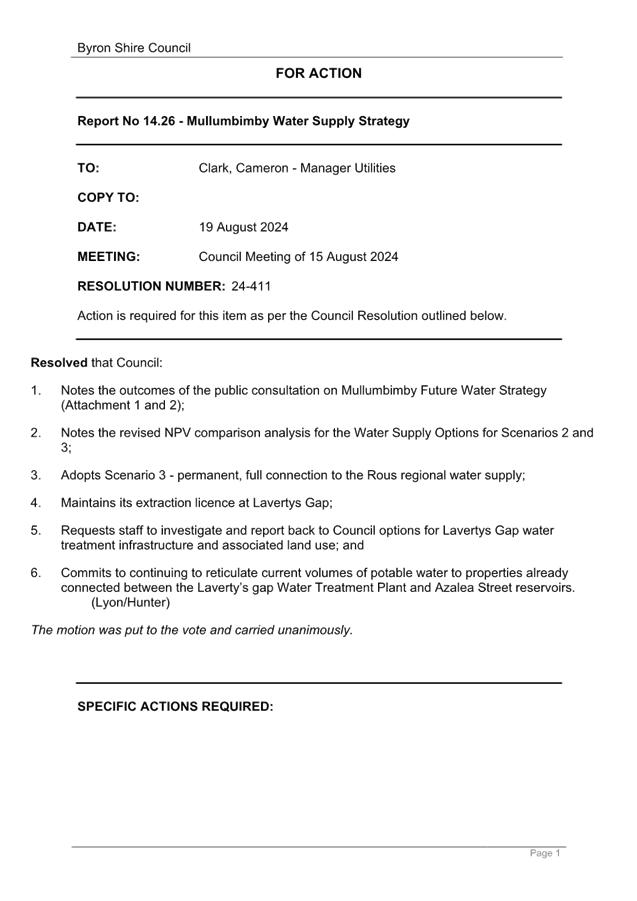
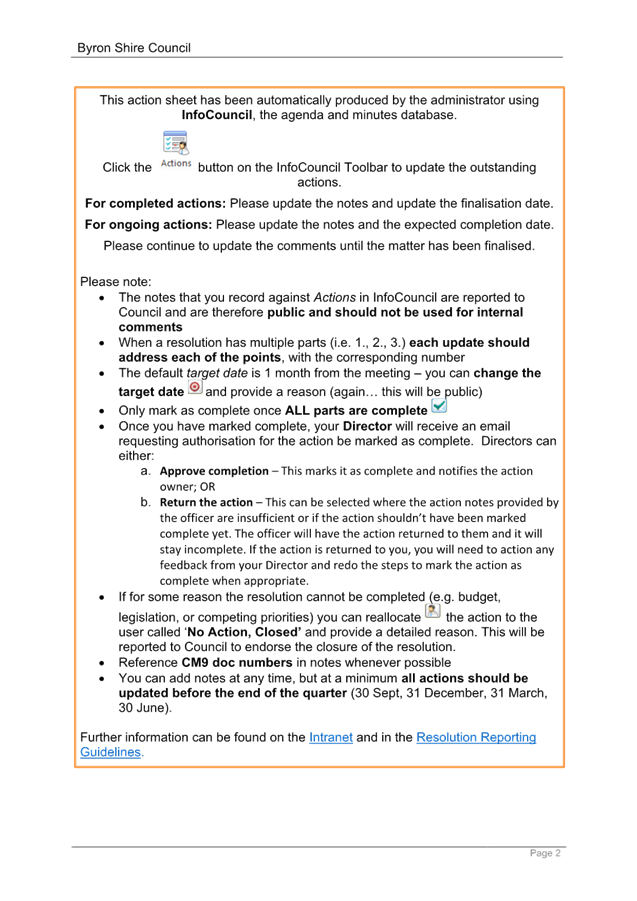
Staff Reports - Infrastructure Services 4.2 - Attachment 4
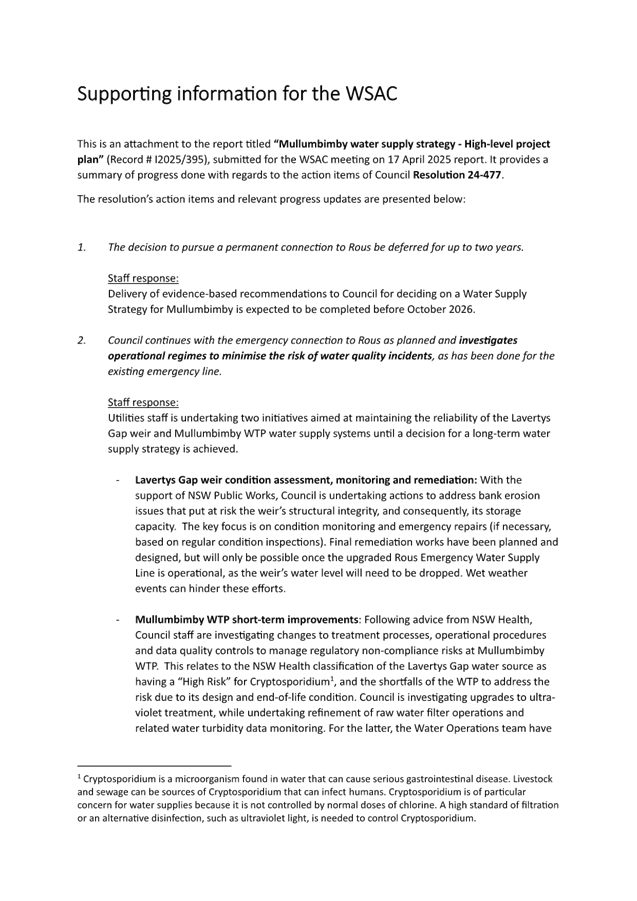
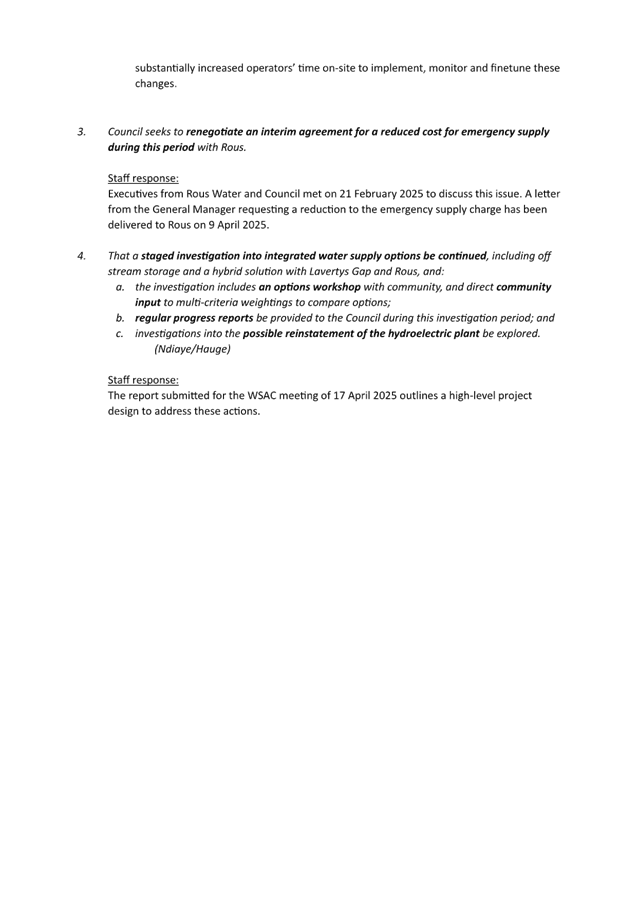
BYRON SHIRE COUNCIL
Staff Reports - Infrastructure Services 4.3
Report No. 4.3 Byron
STP Wetlands Monitoring Report
Directorate: Infrastructure
Services
Report Author: Cameron
Clark, Manager Utilities
File No: I2025/470
Summary:
This report provides a summary of
Byron STP wetlands performance in accordance with the STP Operations
Environmental Management Plan.
RECOMMENDATION:
That the committee note the report.
Report
Australian
Wetlands Consulting (AWC) have been engaged by Byron Shire Council (BSC) to
provide operational support and management for the Byron Bay Integrated Water
Management Reserve, (BBIWMR). This report summarises the key activities,
actions and key findings.
The
BBIWMR includes 15 ha of constructed treatment wetlands and the 24 ha Melaleuca
regeneration system within a total site area of 106 ha. In addition to the
managed wetland and regeneration areas are lands specifically designated for
biodiversity in particular areas managed for frog and grass owl habitat. Refer
to Attachment 1 for a plan showing the OEMP management zones
In 2022 AWC reviewed and updated the BBIWMR Operation and
Environmental Management Plan (OEMP). During this review of the OEMP the
various monitoring and reporting requirements as related to the Byron STP
conditions of approval, legislative requirements and environmental management
obligations were identified. The key reporting and frequency requirements are
summarised in Table 1 – Documentation and Reporting. .
Summary of Key Activities Undertaken 2022-2025
1. Monthly
checklists have been recorded since July 2022, providing knowledge of the site
conditions and how it responds to operational and seasonal changes
2. A comprehensive
asset register has been compiled determining the condition of all the
components within the treatment wetland complex and Melaleuca regeneration area
3. A scientific
trial of salvinia weevils (Cyrtobagous salviniae) for the control of Salvinia
molesta is ongoing with the NSW Department of Primary Industries. December 2022
to June 2026
4. Development and
collaboration with Rous County Council, BSC Bush Regeneration Team and AWC to
detect, monitor and control an outbreak of Amazonian Frogbit
(Limnobium laevigatum)
5. A review and
update to the Byron STP Biodiversity Management Plan
6. A review of Bird
monitoring activities in collaboration with Byron Bay Bird Buddies (BBBB)
7. Bird Surveys
(Australasian Bittern, bimonthly bird surveys)
8. Grass Owl Survey
9. Cane Toad surveys
10. Feral Animal detection and
management
11. Clearing of access and
drains
12. Frog Survey (Wallum Sedge
Frog and Wallum Froglet)
13. Anabat Survey
14. Installation of Nest boxes
(BBBB and Wild BnB)
15. Vegetation Mapping and
Monitoring (2023, 2024 and 2025)
16. Development of maintenance
and repair lists
Table 1 Documentation and reporting requirements
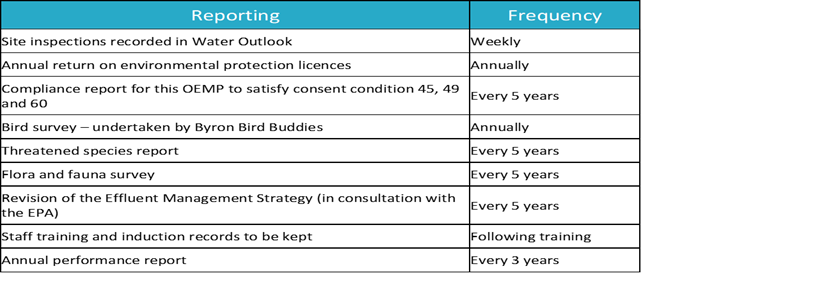
Summary of Key Management Activities
Table
2 summaries the key management activities and actions in relation to the OEMP
and Biodiversity Management Plan and their current status as in April 2025.
Table 2 Management tasks, frequency, location and status
April 2025
|
Management Task
|
Frequency
|
Location
|
Actions and Remediation
|
Status April 2025
|
|
Routine inspection (refer checklist in Appendix D)
Ensure operational areas and public walkways are safe and
accessible.
|
Weekly
|
Designated monitoring and observation points
|
Schedule mowing.
Mowing undertaken as required by external contractor.
Notify Operations Engineer of need for any works (e.g.
stabilisation works)
|
Completed June 2022 to March 2025
|
|
Maintain dense cover of low grasses and sedges on berm
surfaces
|
Monthly
|
Constructed wetland cells
|
Bush regeneration and weed management undertaken as
required by external contractor or the BSC regen team
|
Ongoing condition of edge vegetation has significantly
improved
|
|
Weed management and bush regeneration)
|
Monthly
|
Whole site
|
Bush regeneration and weed management undertaken as
required by external contractor or the BSC regen team
(Refer to West Byron Sewerage Treatment Plant Weed
Management Strategy (DM530123))
|
Ongoing work with DPI as part of weevil trial for
Salvinia control. Ongoing work with BSC Bush Regen Team to control Frogbit.
Successful control on Salvinia in Cell H
|
|
Facilitate the annual Bird Survey
|
Annual
|
Whole site
|
Ensure records are kept and reports provided to NPWS
|
Ongoing
|
|
Create mudflat habitat and manage water levels in Cell H
for bird habitat
|
Ongoing
|
Whole site
|
Refer to Section 4.8 of OEMP
|
In progress
|
|
Communication and engagement with relevant stakeholders
|
Ongoing
|
Whole site
|
Refer to Section 5 of OEMP
|
Ongoing
|
|
Record and monitor plant health and growth
|
Weekly
|
Cells D, E, F, G
Cells I and J
|
Identify areas of poor plant growth or health
|
Ongoing - completed June 2022 to March 2025
|
|
Seasonal drying of wetland cell floors to allow
oxygenation of sediments and germination of wetland plants
|
Annual
|
Cells D, E, F, G
Cells I and J
|
Drain cells slowly and carefully via all outlet valves to
prevent erosion, scour and suspending sediments
Close cells requiring maintenance during dry season.
Cells D or E may need to be drained in mid June –
July to create mudflats for habitat when wet weather prevents this within
Cell H (refer Section 4.8 of OEMP).
|
Partial success (Cells D and E)
Cells I and J have not been possible due to operational
constraints (weather conditions, weed management requirements and no ability
transfer to effluent reuse area)
|
|
Replanting of vegetation at outlets1, in areas
of poor growth and open water.
|
Bi-annually
|
Cells D, E, F, G
Cells I and J
|
Schedule and arrange for replanting and translocation of
healthy plants to areas of poor growth
Ensure appropriate water levels can be provided in
planting areas and consider bird protection
|
Ongoing some trials have been undertaken but the main
focus has been weed control
|
|
Routine inspection of wetland cells for presence and
growth of weeds (refer checklist in Appendix D)
|
Monthly
|
Cells D, E, F, G
Cells I and J
|
Identify and prioritise weed management within the
treatment wetland cells
|
Completed June 2022 to March 2025
Ongoing
|
|
Routine inspections (refer checklist in Appendix D)
|
Monthly
|
Cell H
|
Identify, record, and monitor any maintenance works
|
Completed June 2022 to March 2025
|
|
Maintain water level
|
When water levels drop to 0.45m
|
Cell H inlet
|
Maintain water level >0.45m and <1.0m
Top-up cell to 0.65m when water level reaches 0.45m
|
Completed June 2022 to March 2025
No top ups required
|
|
Create mudflat habitat
|
Annually (in mid June – July)
|
Cell H or alternatively Cells C and D
|
1. Open valves to lower water level to
approximately 0.4m to expose mudflats
2. Allow area to dry
3. Slash vegetation
4. Raise water level to 0.8m – 1.0m to
kill remaining vegetation
If wet weather prevents the creation of mudflats in Cell
H, Cell D or E shall be drained to create mudflats.
|
Ongoing has been partially completed. Increase in waders
and waterbirds in Cells D and E
|
|
Maintain wet season water level of 0.8m
|
Wet season
(~Nov-Mar)
|
Cell H
|
To prevent inundation of plants and loss of habitat
|
Complete
|
|
Maintain water quality
|
As required
|
Cell H
|
Top up cell following significant rainfall events
(>25mm/day)
|
Not required due to climatic conditions
|
|
Remove weeds
|
3 monthly
|
Cell H
|
Refer to West Byron Sewerage Treatment Plant Weed
Management Strategy (DM530123)
|
Ongoing
|
|
Routine inspection (refer checklist in Appendix D)
|
Monthly
|
24ha area
|
Identify, record, and monitor any maintenance works
|
Completed June 2022 to March 2025
Ongoing
|
|
Manage weeds within the 24ha
|
Monthly
|
24ha area
|
Identify, record, and monitor any required weed
management tasks
|
Completed June 2022 to March 2025
Ongoing
|
|
Monitor groundwater quality
|
Continuously
|
Groundwater monitoring wells
Refer Appendix C
|
Record pH, conductivity and temperature
|
Completed June 2022 to March 2025
Ongoing
|
|
Monitor groundwater levels
|
Continuously
|
3 x Groundwater monitoring wells Refer Appendix C
|
Record groundwater levels to inform irrigation
application and to manage ASS
|
Completed June 2022 to March 2025
Ongoing
|
|
Maintain groundwater levels above 600mm below ground
level (BGL)
|
Monthly
|
Groundwater monitoring wells
Refer Appendix C
|
Increase irrigation when ground water level drops below
600mm
|
Completed June 2022 to March 2025
Ongoing
|
|
Fluctuate the water table level by 300mm increments
|
3 monthly
|
Groundwater monitoring wells
Refer Appendix C
|
Reduce surface pyrite formation during periods of
waterlogging
1. Raise water table to 300mm (BGL) for one month
2. Raise to surface and maintain for three months
|
Completed June 2022 to March 2025
Ongoing
|
|
Minimise surface ponding
|
Monthly
|
Irrigation area
|
Avoid irrigating following rainfall events
|
Not applicable
|
|
Maintain pH below 5.2
|
|
Groundwater monitoring wells
|
Lower the water table when pH approaches 5.2
|
Completed June 2022 to March 2025
Ongoing
|
|
Maintain pH above 3.5
|
|
Groundwater monitoring wells
|
Raise the water table when pH approaches 3.5
|
Completed June 2022 to March 2025
Ongoing
|
|
Record observations of threatened species
|
During site inspection or when sighted
|
All areas of the BBIMWR
|
Record and document threatened species occurrence on the
site
|
Completed June 2022 to March 2025
Ongoing
|
|
Ensure contractors and visitors receive the necessary
training and communicate the requirement to protect frog and owls on the site
|
Ongoing
|
All areas of the BBIMWR
|
Provide induction and training to contractors and site
visitors
|
Ongoing
|
|
Manage weeds and feral species to prevent impacts to
habitat
|
Ongoing
|
All areas of the BBIMWR
|
Bush regeneration and weed management undertaken as
required by external contractor or the BSC regen team
(Refer to West Byron Sewerage Treatment Plant Weed
Management Strategy (DM530123))
|
Completed June 2022 to March 2025
Ongoing
|
|
Ensure that works are ceased in the event of grass owl
detection
|
Ongoing
|
All areas of the BBIMWR
|
Follow Grass Owl Protection Procedure as detailed in
4.10.1
|
Completed June 2022 to March 2025
Ongoing
|
|
Undertake required monitoring of threatened fauna
|
Annually
|
Targeted Locations in the BBIWMR
|
Update Biodiversity Management Plan
|
Complete June 2022 to March 2025
|
|
Category
|
Performance criteria
|
Status April 2025
|
|
Constructed Wetlands (D, E, F, G, I & J)
|
· Emergent weeds and invasive natives are
controlled and comprise ≤5% total cover within each cell
· Native macrophyte vegetation is dense and
healthy (>80% coverage of native macrophytes >80% of the time)
· Cell batters where access to operational
infrastructure is not required are densely vegetated
|
· Emergent and floating weed cover in Cells D
and E <5% total
· Emergent and floating weed cover in Cells F
ang G and I and J exceed performance criteria
· Cells batters where access is not required are
densely vegetated
· Native macrophytes dominate Cells D and E
|
|
Cell H
|
· Contains all of the following wetland
habitats:
o Open water with floating macrophytes (bottom and middle
of cell)
o Native emergent macrophytes (top and edges of cell)
o Native woody vegetation on the north-eastern berm only
o Mudflats (from August – March inclusive)*
· Emergent weeds and invasive natives are
controlled and comprise ≤5% total cover within each cell
· No decline in plant species diversity
· Cell batters where access to operational
infrastructure is not required are densely vegetated
· Predatory native fish populations such as Eel and Mullet
are present
· Minimum water depths required for Comb-crested
Jacana are maintained
· Works avoided in Cell H during Jacana breeding
season
|
· Open water in bottom and middle of cell with floating
macrophytes
· Emergent weeds (including floating) and
invasive natives cover in cell H <5% total
· Native emergent macrophyte coverage (top and
edges of cell) stable and healthy
· Native woody vegetation on the north-eastern
berm only
· Mudflats to be developed from August 2025
· No observed decline in plant species diversity
· Cell batters where access is not required are
densely vegetated
· Predatory native fish populations such as eel
and mullet present
· Minimum water depths required for comb-crested
Jacana present
· Works avoided in cell H during Jacana breeding
season
|
|
24 Hectare Melaleuca Regeneration Habitat
|
· Emergent weeds controlled and comprise
≤5% total cover
· Optimal water use to maintain plant health and
evapotranspiration
|
· Emergent weeds controlled and compromise
<10% total cover
· Water use in 24Ha impacted by loss of critical
infrastructure and downstream drain condition
|
|
Frog and Grass Owl Habitat
|
· Emergent weeds controlled and comprise
≤5% total cover
· Native vegetation continues to persist and
structurally provide suitable Grass Owl habitat which is not degraded or
disturbed
· Water chemistry is between a pH range of 3
– 5
|
· Emergent weeds controlled and compromise
<5% total cover
· Native vegetation present and healthy
providing suitable Grass Owl habitat
· Water pH between 3-5
|
|
Acid Frogs
|
· Existing/known habitat areas continue to be
utilised by Acid Frog species
· Native vegetation within Acid Frog habitat
areas (constructed wetlands, Frog and Grass Owl Habitat) continues to persist
and is not degraded or disturbed
|
· Existing/known habitat areas for Acid Frogs
continue to be utilized
· Native vegetation within Acid Frog habitat
areas has continued to persist and has not degraded or disturbed
|
|
Grass Owl
|
· Existing/known habitat areas continue to be
utilised by Grass Owls
· Native vegetation within Frog and Grass Owl
Habitat areas continues to persist and structurally provide suitable Grass
Owl habitat which is not degraded or disturbed
|
· No Grass Owls detected during monitoring
surveys
· Habitat areas persist and further vegetation
survey required
|
|
Bats
|
· Existing/known habitat areas continue to be
utilised by insectivorous bats
· Native vegetation within suitable habitat
areas (constructed wetlands, Frog and Grass Owl Habitat and 24ha Melaleuca
Habitat) continues to persist and is not degraded or disturbed
|
· Bat survey complete
· Native vegetation supports bat presence on the
site
|
|
Feral Animals
|
· Feral species, particularly Cane Toads do not
become established within cells
· Densely vegetated cell batters maintained
· Feral animal trapping/control actions are
initiated should populations be observed within the BBIWMR
|
· Feral Species, cane toads present on the site
· Densely vegetated cell batters maintained
· Feral animal trapping/control actions are in
place
|
|
Threatened Birds
(Comb-crested Jacana, Australasian Bittern, Black-necked
Stork, Black Bittern)
|
· Populations distributions and abundances of
threatened waterbird species are monitored annually, particularly during
breeding events
|
· Monthly Bird surveys carried out annually to
monitor population distributions and abundances of threatened waterbird
species, particularly during breeding events
|
|
Threatened shorebirds
|
· Populations distributions and abundances of
threatened waterbird species are monitored annually, particularly during
breeding events
|
· Monthly Bird surveys carried out annually to
monitor population distributions and abundances of threatened waterbird
species, particularly during breeding events
|
Significant Events 2022-2025
A
number of significant events occurred at the BBIWMR during the period 2022 to
April 2025. These include complete removal of Salvinia from the biodiversity
wetland Cell H. (see Figures 1 and 2)
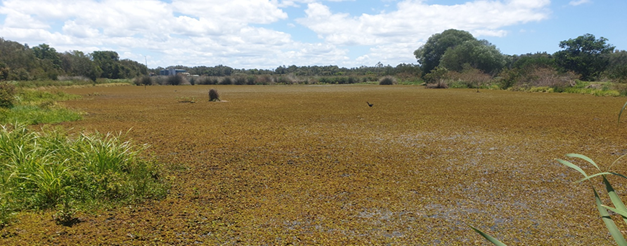
Figure
1 Cell H December 2022 Complete Salvinia Cover
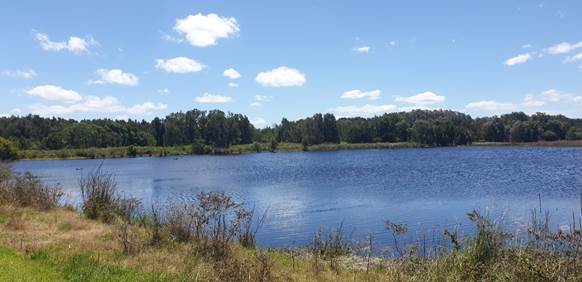
Figure 2 Cell H January 2023 Salvinia clearance due to
weevil control
In
October 2023 a large bushfire occurred impacting a significant portion of the
site (Figure 3 Extent of fire 2023). Since this time operation of the effluent reuse area has
not been possible.
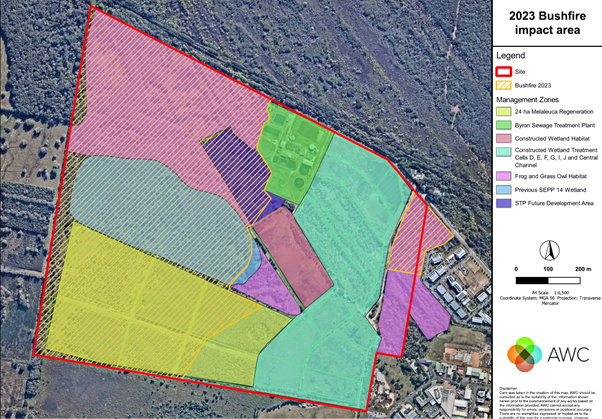
Figure 3 Extent of fire 2023
A
comprehensive audit and assessment of the condition of all site infrastructure
was undertaken 2023 -2024 (See Figure 4)
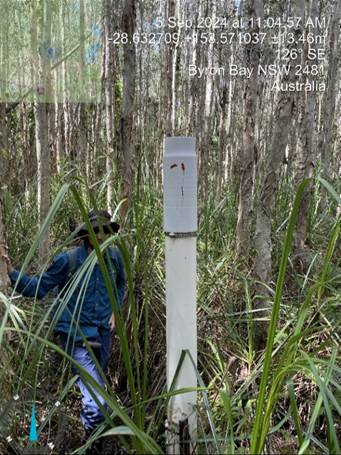
Figure 4 Undertaking asset condition assessment in the 24ha
regeneration area September 2024
Amazonian
frogbit was detected in Cell H and Cells D and E in 2024.
A
number of significant rainfall events occurred during the period with
conditions generally being wetter than average limiting the maintenance
activities that could be undertaken on the site.
Works to be undertaken 2025 – 2026
The
following points identify tasks to be undertaken in the next 12-18 months
· Workshop with BBBB Review of Monitoring (20 years of data,
key trends, review of monitoring strategy)
· Installation of Automated Logging System 24ha and Cell J
(Water level, pH)
· Downstream drain management
· Assessment of Acid Sulphate Soils and review of ASS
Management Plan for the BBIWMR
· Completion of compliance reporting
· Continuation of required biodiversity monitoring
· Further monitoring of vegetation condition
· Repair and reactivation of 24 Melaleuca Regeneration area
· Repair and renewal of assets as identified by the asset
condition register
Condition of the System Summary
The
treatment wetland cells were commissioned as part of the 2006 capital works
program and components of the system are now in need of replacement and renewal
in order to ensure that the wetland system provides the required polishing
function for treated effluent from the Byron Bay STP.
The
wetland cell inlets in particular have reached the end of their functional life
and are now not providing even distribution of effluent flow across the top of
the cells. In a number of locations water depths do not support the
establishment of dense healthy aquatic macrophyte vegetation. There is also
Acid Sulphate Soils underlying Cell D.
Weed
management requirements on the site are significant and require sustained
effort to but some areas of improvement are evident particularly Cells D, E and
H.
Since
the bushfire the operation of the 24ha regeneration area has not been feasible.
Much of the infrastructure was completely destroyed.
Condition
of Cell H has improved with Salvinia control with more bird activity and Black
Necked Storks observed on two occasions.
Migratory
bird activity also appears to have improved with Latham’s snipe detected
in 2024. Grass Owls were not detected on the site in survey undertaken in 2024.
BYRON SHIRE COUNCIL
For Information Only 6.1
For Information Only
Report No. 6.1 Infrastructure
Services Utilities Monthly Status Report December 2024 - February 2025
Directorate: Infrastructure
Services
Report Author: Cameron
Clark, Manager Utilities
File No: I2025/434
Summary:
This report summarises the
performance of Utilities delivery during the period December 2024 to February
2025.
Recommendation:
That the Committee note the
report.
Report
DRINKING WATER QUALITY
In February 2025 there were three
(3) exceedances related to turbidity.
January 2025 there were zero (0)
and in December 2024 there were two (2) exceedances at Mullumbimby WTP related
to level sensor technical faults.
NSW Health Water Quality
Monitoring
The tables below detail the
performance of the water supply network for 2025.
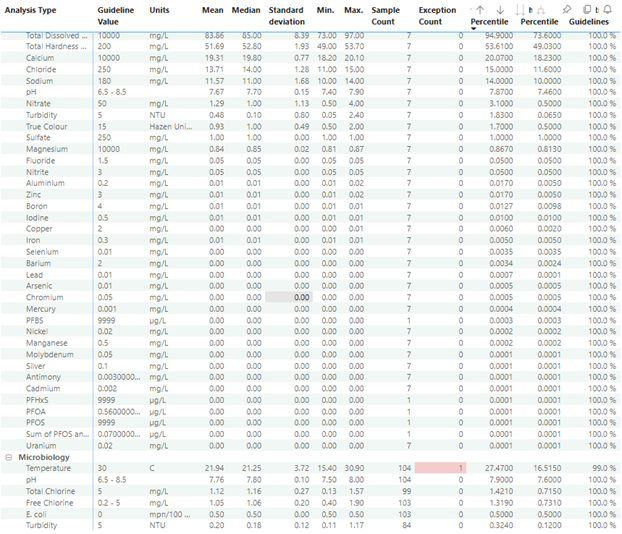
Incident Reports and Public
Health Reportable Events
There were zero (0) Public Health
reportable events and NSW Health Sampling non-compliances in February, January
2025.
EPA Reportable Events
There were zero (0) EPA reportable
incident during February, January 2025 and December 2024.
ASSET MAINTENANCE MANAGEMENT
Continuous Improvement Actions
Recent Improvements:
1. Property water meters have
already been brought into the system and reactive maintenance tasks are
routinely logged against these. The geographical location of the meters
could not be discerned as part of the GIS upload and therefore meters are currently,
in general, located in the centre of each lot. We are currently
undergoing a process of relocating each meter to the correct location in line
with information held in the Water Billing system. Currently:
a. Mullumbimby, Bangalow, and
Brunswick Heads are complete and service lines have been generated.
b. Suffolk Park is at
approximately 35% completion and will be included in the system in the coming
weeks.
2. Following recent update to
the Assetic platform, changes have been made to the Planned Maintenance
programming and the Asset catalogue to create separate Work Groups for
operational teams. Previously all teams were within one Water and Sewer Work
Group, which cluttered workspaces and required complex filtering to avoid
seeing all work for all teams. Moving forward, all PM tasks will be generated
within their appropriate Work Groups. Team leaders and supervising staff who
create work orders for reactive work have been notified of this change.
3. Because of the live nature
of current reporting integrations between Assetic and Power BI, there is not
currently a way to look back on the state of the system as it was in any given
month in the past. The IT Team have created a series of history tables that
will be appended at the end of every month, essentially creating easily
reportable snapshots of the Assetic system to track KPIs, as seen below
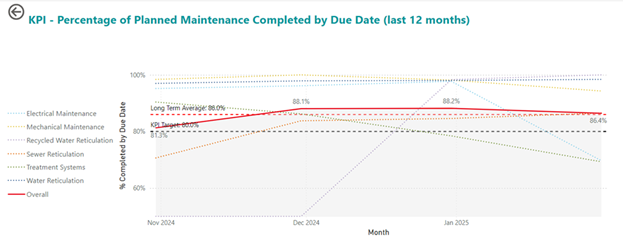
Next Steps:
1. Weekly meetings with team
leaders were suspended over the Christmas/New Year break and have resumed to
drive further improvements to the Assetic System.
2. With the ongoing effort to
digitise and properly catalogue plans and important asset-related documents,
the team will soon be uploading more of these documents to Assetic to be easily
accessible to field staff when needed.
ASSET MAINTENANCE STATUS
Planned Maintenance –
Progress against Program
Overall, Utilities planned
maintenance in February is 89.6% tasks completed by due date against a target
of 80%. The current long-term average of tasks completed by due date is 86.7%.
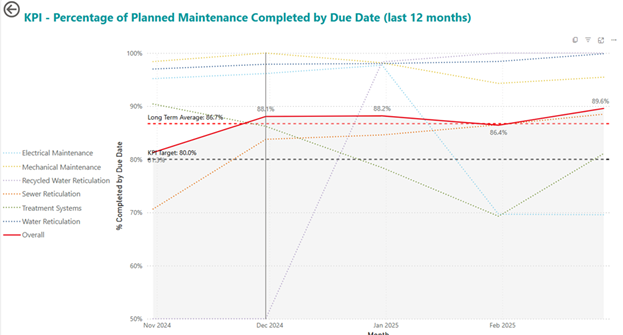
Planned versus Reactive
Maintenance
The figure below shows the
comparative maintenance hours for each team between planned and reactive
maintenance. Reactive maintenance has taken 67.0% of all hours spent working on
assets for the last 12 months.
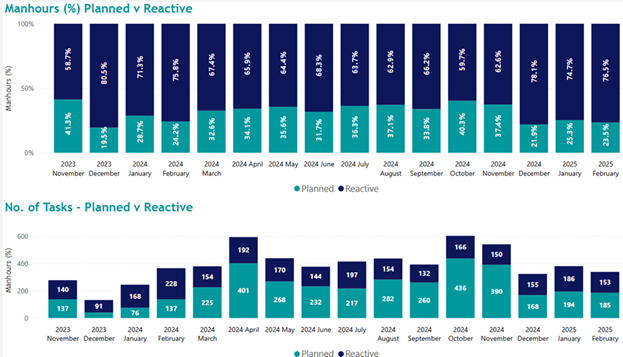
CAPITAL WORKS
SPS Renewals for Byron, Mullum,
Ocean Shores & Bangalow
|
SPS
|
% COMPLETE
|
PUMPS
DELIVERED
|
SWITCH-
BOARD
DELIVERED
|
COMPLETED
SCOPE SUMMARY
|
|
SPS 1002
|
100
|
N/A
|
Delivered
|
Casted new
switchboard pad and installed new 3x 63mm electrical conduits and new 32mm
mains onto pumps. Switchboard installed. Made good old switchboard plinth and
penetrations into well and valve chamber. Restoration completed.
|
|
SPS 1005
|
100
|
N/A
|
Delivered
|
Removed existing
broken sealed surface and re-asphalt access road
|
|
SPS 1007
|
100
|
N/A
|
Delivered
|
MH and bypass
connection installed. NPE by pass pumps demob. Epoxy works completed and SPS
back in operation. Add spindle (SS316) on inlet valve. Replaced risers in PE
125 and replaced lifting chains in SS. Installed new switchboard on new
concrete pad (1960x1600x200) with new odour filter and old concrete plinth
removed. 3x63mm conduit 16mm electric main installed. Penos with 2 parts mega
poxy (5-10mm) concluded. Replaced odour filter to ground mount McBerns
filter. Water service to be relocated. Fixed padlock cover on lid.
Restoration completed.
|
|
SPS 2002
|
100
|
N/A
|
Delivered
|
Completed
replacement of risers PE125 through to the valve chamber, no need for valves.
New PE pipe connected directly into valves to save space. New Spindle on
SS316 was installed. Restoration completed.
|
|
SPS 2004
|
100
|
N/A
|
Delivered
|
Replace existing
DN150 gate valve in the 2002 rising main on outside of well
|
|
SPS 2010
|
100
|
N/A
|
Delivered
|
Replaced risers
PE180, DN150 outlet gate valves, check valves, Gibault and flanged spigot.
Installed new Switchboard pad (1600x1600x200). 3 x 63mm electrical conduits
installed to green boy approx. 120m away. Water Service relocated. Excavation
under high water table needed dewatering system. Restoration completed.
|
|
SPS 3004
|
100
|
N/A
|
Delivered
|
Bypass
completed, Epoxy Coating and crack injections completed, Standpipe and
ductile iron manifold updated to HDPE.
|
|
SPS 3010
|
100
|
N/A
|
Delivered
|
Replaced risers
PE125 from elbow on wet well to valve pit, DN150 outlet gate valves, check
valves. Relocated water service. Restoration completed.
|
|
SPS 3017
|
100
|
N/A
|
Delivered
|
Replaced inlet
gate valve and refurbish inlet pipe penetration
|
|
SPS 3021
|
100
|
N/A
|
Delivered
|
Construction
completed. Replaced DN125 risers, DN100 outlet gate valves, check valves,
DN150 inlet gate valve, replace guide rails and brackets, relocated water
service, removed vent pole and replaced with McBerns odour filter, removed
switchboard plinth and replace switchboard. Restoration completed.
|
|
SPS 4007
|
N/A
|
N/A
|
Delivered
|
Removed
from scope
|
|
SPS 5003
|
N/A
|
N/A
|
Delivered
|
Removed
from scope
|
|
SPS 5014
|
100
|
N/A
|
Delivered
|
New switchboard
plinth cast done, already installed new 3x63mm conduits to pump well,
removing existing conduits and grout. No need to remove part of the fence.
New electrical mains from green boy to board completed, new switchboard and
commission with electricians had issues but a work around was completed.
Running on new switchboard. Restoration completed.
|
|
SPS 5017
|
100
|
N/A
|
Delivered
|
Completed the
replacement of the DN125 risers, DN100 outlet gate valves, check valves and
dismantling joints, DN150 inlet gate valve and spindle as well as handrail
around new switchboard platform. Old platform was removed, switchboard
replaced as well as new electrical mains. Water service relocated.
Restoration completed.
|
|
SPS 5020
|
100
|
N/A
|
Delivered
|
Completed the
install of the 2 x new DN125 PE riser pipes through to the valve chamber, new
gate valves and check valves, Gibault and flanged spigots. New gate valve
DN150 on incoming gravity sewer. New slab for switchboard (3120x1000x200) was
casted. Applied bitumen coat on spigot. Removed the Ladder. Restoration
completed.
|
|
SPS 5022
|
100
|
N/A
|
Delivered
|
Installed new
switchboard, conduits, electric main and new concrete platform. Removed existing
switchboard and concrete plinths and installed new switchboard on new
platforms. Pipework is also completed as well as stairs. Relocated water
service. Installed new Covers, grill and frames sealed for odour control.
Handrails were installed and existing plinth was modified to suit new ground
mount odour filter. Restoration completed.
|
Gravity Sewer Mains Remediation
Based on previous condition
assessments of the gravity sewer main network, Willow and Sparrow identified
mains that required remediation works to prolong their use and/or to fix acute
defects. The remediation scope included the installation of patch liners,
excavation and repair, and CCTV survey. This package of works was awarded
to Subsurface Pipe Solutions to a value of $132,950 plus GST. Work has
commenced and is currently running on schedule. There has been some variation
in scope due to previously unknown site and asset conditions which has resulted
in lowering the overall budget whilst maintaining the desired outcomes. This
project is nearing completion.
Gravity Sewer Condition
Assessments
The condition assessment of
gravity sewer mains and maintenance holes was awarded to Willow and Sparrow
(maintenance holes) and Subsurface Mapping Solutions (mains). The
Maintenance hole condition assessments are underway. The CCTV mains contract
was awarded to Subsurface Mapping Solutions and work is scheduled to be
completed by June 30. The sewer catchments that fall within this scope
are across Bangalow, Suffolk Park, and Ocean Shores. The indicative
budgetary limit of ~$320,000 will cover the costs for both CCTV assessments and
MH visual assessments. Condition assessment reports for mains and maintenance
holes will be completed once all data has been gathered.
Water Main Replacements –
Supply and Installation: Fletcher St, Carlyle St and Bangalow Rd Byron Bay; and
Azalea St Mullumbimby
Site 01 Carlyle Street –
Byron Bay
• Construction
is completed – Planit and CivilCS are to review and finalise WAE and
ITPS;
Site 02 Azalea Street –
Mullumbimby
• Construction
is completed – Planit and CivilCS are to review and finalise WAE and
ITPS;
• CivilCS
to complete final remediation works.
Site 03 Fletcher Street–
Byron Bay
• Construction
is completed – Planit and CivilCS are to review and finalise WAE and
ITPS;
• CivilCS
to complete final remediation works.
Site 04 Bangalow Road –
Byron Bay
• Construction
is completed – Planit and CivilCS are to review and finalise WAE and
ITPS;
• CivilCS
to complete final remediation works.
Paterson St Reservoir
Replacement
Work accomplished in the
period:
• Michael
Salu (SSE) has finalized the structural engineering concept designs (exclusive
of stairs).
• Planit
has now issued their Concept Design Plans for Council review.
• A meeting
with the telcos occurred mid-December. Agreement was made to progress the
Concept Design to Detailed Design. Council need to review the concept plans and
a new fee proposal is required to be submitted by Planit.
Telcos – Paterson: NO
CHANGE FROM MAY 2023
• A meeting
was held with BMM Group (who act on behalf of all major Telcos)
• BSC and
BMM have agreed on a concept design for the antenna locations and Telco access
to the antennas – being from a Telco gantry off the side of the
reservoir, NOT via the BSC stairs and roof.
• Planit to
provide survey and concept design to BMM to allow them to proceed with planning
approvals and draft design of the access and antenna connections.
• Concept
structural plans have now been issued to the telecos for comment.
Mullumbimby Emergency Trunk
Water Main Construction
Work accomplished in the
period:
• The
project has now commenced construction.
• UGL
Regional Linx held a meeting as they required additional information to provide
approval. Plans were updated accordingly with the water main being 4.1m deep to
accord with their standard requirements.
Ewingsdale Road Water Main
Work accomplished in the
period:
• Planit
has now completed the detailed design of this water main, inclusive of the
structural engineering design of the water main brackets.
• ENV
Solutions has now completed their ASSMP Report.
• Plans
were reissued to show survey marks.
• Design
now under staff review.
Main Arm Road Concept Water
Main
Work accomplished in the
period:
• Project
postponed to FYE2027 due to budget resource constraints.













































































































































